
No videos yet!
Click on "Watch later" to put videos here

Madagascar Travel Guide – Everything You Need to Know

Madagascar, located off the southeastern coast of Africa, is a mesmerizing island nation that beckons travelers with its unique and diverse natural wonders. Renowned for its extraordinary biodiversity, this “eighth continent” boasts lush rainforests, otherworldly landscapes, and a coastline teeming with marine life. As a hotspot for ecotourism, Madagascar offers opportunities to encounter rare lemurs, explore untouched wilderness, and relax on pristine beaches. Its rich cultural tapestry, influenced by African, Asian, and European heritage, adds depth to the visitor’s experience. For those seeking an off-the-beaten-path adventure in a place unlike any other, Madagascar is a captivating destination waiting to be explored.
What’s the Best Time to Visit? 📅
The best time to visit Madagascar as a tourist largely depends on your interests and the experiences you seek, as the country experiences different climate zones. Generally, Madagascar has two main seasons: the dry season (winter) and the wet season (summer). Here’s a breakdown of the best times to visit:
- June to September: This period, especially July and August, is considered the peak tourist season. The weather is generally dry, and temperatures are cooler, making it an ideal time for wildlife viewing, hiking, and exploring the country.
- April to June: Early in the dry season, the landscapes are lush and green, and the weather is pleasant. It’s an excellent time for birdwatching and photography.
- November to December: The start of the wet season sees sporadic rains, but it’s still a good time to visit, as many animals are giving birth, and the landscapes are vibrant.
- January to March: These months constitute the peak of the wet season, with heavy rains and high humidity. Some roads may become impassable due to flooding, and some national parks may close temporarily. However, this is a great time for surfers and those interested in lush, green scenery.
- October and November can be considered shoulder months, offering a balance between the dry and wet seasons. The landscapes are still green, and wildlife is active, but there’s a lower influx of tourists.
- If you’re interested in whale watching, particularly humpback whales, the best time is from July to September. You can spot these magnificent creatures along the coast, especially near Île Sainte-Marie.
- Check the dates for cultural festivals, such as the Donia Music Festival in Nosy Be and the Aloalo Festival in Toliara, and plan your visit accordingly for a unique cultural experience.
Keep in mind that Madagascar is a large island with regional variations in climate. The eastern side is generally wetter than the western side, which experiences a rain shadow effect. Coastal areas are typically more humid than the highlands.
Before planning your trip, consider the specific activities and regions you want to explore, as well as the type of climate that suits your preferences. Always check current weather conditions and travel advisories before embarking on your journey to Madagascar.
What’s the Best Way to Get Around? 🚌
Getting around Madagascar as a tourist can be an adventure in itself, as the country’s transportation infrastructure is still developing. Here are some of the best ways to get around Madagascar:
- Domestic flights are the fastest way to cover long distances in Madagascar. Airlines like Air Madagascar and Tsaradia operate regular flights between major cities and tourist destinations.
- Be prepared for potential delays and changes in flight schedules due to weather conditions.
- Renting a car with a driver or a 4×4 vehicle is a convenient option, especially for exploring remote or less accessible areas. Roads in Madagascar can be challenging, so having an experienced driver is recommended.
- Self-driving is possible but can be more challenging due to road conditions and navigation.
- These are shared, long-distance taxis that connect major towns and cities. They are often the primary mode of transportation for both locals and budget-conscious travelers.
- Be prepared for crowded and sometimes uncomfortable rides. Taxis-brousse schedules can be unpredictable, so plan your journey accordingly.
- In cities and towns, you can use local taxis and pousse-pousses (cycle rickshaws) for short trips within urban areas.
- Negotiate fares in advance or ensure that the taxi driver uses the meter.
- These are small shared minivans that travel between towns and cities. They offer a balance between comfort and affordability, and they are a common mode of transport for locals.
- Expect a flexible schedule and possible delays.
- If you plan to explore Madagascar’s coastal areas and islands, ferries and boats are essential. This includes routes to places like Île Sainte-Marie and Nosy Be.
- Ferry schedules can be irregular, so check in advance.
- In some areas, such as national parks and rural villages, walking and hiking are the primary means of transportation. Guided treks and hikes are available in many scenic locations.
- In urban areas and some tourist destinations, you can rent bicycles or scooters for local exploration. This provides flexibility and a more intimate experience of the surroundings.
- For a hassle-free experience, consider booking guided tours with reputable tour operators. This can include transportation, accommodation, and guided activities.
- In cities like Antananarivo, ride-sharing apps like Bolt and local transportation apps can be convenient for getting around within urban areas.
Keep in mind that travel in Madagascar can be slow and sometimes unpredictable due to road conditions, weather, and other factors. Plan your itinerary with extra time for unexpected delays, and always prioritize safety, especially when traveling in remote or less-developed areas.
What’s the Official Language?
The official languages of Madagascar are Malagasy and French. Malagasy is the national language and is widely spoken by the Malagasy people. French is used in government, education, and business and is understood by some Malagasy people, especially in urban areas. Here are some basic Malagasy phrases for tourists:
- Hello – Salama (sah-lah-mah)
- Good morning – Manao avo lavo (mah-now ah-voh lah-voo)
- Good afternoon – Manao androana (mah-now ahn-droo-ah-nah)
- Good evening – Manao hariva (mah-now hah-ree-vah)
- Good night – Good night (mah-now ah-rev-ay)
- Thank you – Misaotra (mee-sah-oh-trah)
- Yes – Eny (eh-ny)
- No – Tsia (tsi-ah)
- Please – Azafady (ah-zah-fah-dy)
- Excuse me / I’m sorry – Azafady (ah-zah-fah-dy)
- What is your name? – Inona ny anaranao? (ee-noo-nah ny ah-nah-rah-now)
- My name is [Your Name] – [Your Name] no anarako (your name no ah-nah-rah-koo)
- How much is this? – Ohatrinona ity? (oh-ha-tree-noo-nah ee-ty)
- Water – Rano (rah-no)
- Food – Akoho (ah-koo-oh) [for chicken]
- Bathroom/Toilet – Trano boky (trah-noh boh-ky)
Learning a few basic Malagasy phrases can enhance your travel experience in Madagascar and show respect for the local culture. The Malagasy people are generally appreciative when visitors make an effort to speak their language, even if it’s just a few words. French can also be useful, especially in larger cities and tourist areas.
Where to Stay? 🏨
Madagascar offers a variety of accommodation options to suit different preferences and budgets. The type of accommodation you choose will depend on your itinerary and the experiences you seek. Here are some popular types of accommodations and regions to consider when staying in Madagascar as a tourist:
- Hotels: In major cities like Antananarivo, Nosy Be, and Toliara, you’ll find a range of hotels, from budget to luxury. These hotels offer various amenities and services, making them suitable for travelers seeking comfort and convenience.
- Lodges and Resorts: Madagascar has beautiful beachfront lodges and resorts along its coastline, particularly in destinations like Nosy Be, Île Sainte-Marie, and Anakao. These offer stunning views, water-based activities, and a luxurious experience.
- Guesthouses: Guesthouses are a common and affordable accommodation option in both urban and rural areas. Staying in a guesthouse can provide a more intimate and local experience.
- Ecolodges: Madagascar is known for its unique biodiversity, and staying in ecolodges allows you to immerse yourself in nature while supporting sustainable tourism. They are often located in or near national parks.
- Beach Bungalows: Along Madagascar’s coast, especially in places like Ifaty and Anakao, you’ll find cozy beachfront bungalows where you can enjoy a laid-back atmosphere and beautiful sunsets.
- Homestays: For a genuine cultural experience, consider staying with local families through homestay programs. This allows you to learn about Malagasy customs, cuisine, and daily life firsthand.
- Tented Camps: In national parks and wildlife-rich areas, you can stay in tented camps. These camps offer a unique experience, bringing you closer to nature and wildlife.
- Budget Hostels: In larger cities like Antananarivo and Antsiranana, you can find budget hostels that cater to backpackers and budget-conscious travelers.
- Campgrounds: If you’re an adventurous traveler, some areas in Madagascar offer campgrounds where you can set up your own tent and enjoy the great outdoors.
- Floating Hotels: In some regions like the Pangalanes Canal, you can find floating hotels that provide a unique and serene experience as you navigate the waterways.
When choosing accommodation in Madagascar, consider factors such as your budget, the location of your activities and attractions, and the amenities you desire. During peak tourist seasons, especially in popular tourist destinations, it’s advisable to book your accommodations in advance to secure your stay. Additionally, read reviews and check the current status of the accommodations you’re interested in, as conditions can vary widely.
What to Eat? 🍽️
Madagascar offers a unique and diverse culinary experience influenced by African, Asian, and French flavors. While exploring the island as a tourist, be sure to try these must-try Malagasy dishes and foods:
- Ravitoto: This traditional Malagasy dish is made from cassava leaves and shredded meat (often pork or beef) cooked in coconut milk. It’s a hearty and flavorful comfort food.
- Romazava: Romazava is a popular Malagasy meat and vegetable stew cooked with a variety of greens, including spinach and mustard greens. It’s often served with rice.
- Akoho sy Voanio: This dish features chicken (akoho) cooked with ginger, garlic, and coconut milk (voanio). It’s a delicious and creamy chicken stew, typically served with rice.
- Koba: Koba is a sweet treat made from peanuts, sugar, and rice flour. It’s wrapped in banana leaves and makes for a delightful snack.
- Laoka: Laoka refers to the side dishes served with rice, and they can include a variety of ingredients such as vegetables, beans, seafood, and meats. Try different laoka dishes to experience the diversity of Malagasy cuisine.
- Sambos: These are similar to samosas and are a popular snack. Sambos are pastry parcels filled with various ingredients like vegetables, meat, or seafood.
- Brochettes: Brochettes are skewered meats, often marinated and grilled. They are a common street food and can include beef, chicken, zebu (a type of cattle), or seafood.
- Camarons: Madagascar is known for its freshwater prawns, and you can enjoy camarons prepared in various ways, such as grilled or in a rich garlic and tomato sauce.
- Foie Gras: Due to French influence, foie gras is produced in Madagascar, and it’s considered a delicacy. You can find it served in upscale restaurants.
- Street Food: Don’t miss the opportunity to explore the local street food scene. Try snacks like mofo (rice cakes), bokoboko (fried dough), and various grilled snacks from street vendors.
- Fruits: Madagascar is abundant in tropical fruits like mangoes, lychees, pineapples, and passion fruits. Enjoy these fresh and flavorful fruits during your visit.
- Coffee: Madagascar produces some excellent coffee, and you can savor local brews, often served strong and rich.
- Rhum Arrange: Try rhum arrange, a popular local rum infused with various spices and fruits. It’s a flavorful and aromatic drink.
- Vanilla: Madagascar is one of the world’s largest producers of vanilla, so be sure to try desserts and dishes flavored with pure Madagascar vanilla.
- Street Markets: Explore local markets to sample a variety of fresh and exotic produce, snacks, and spices. It’s a great way to experience the vibrant food culture of Madagascar.
Malagasy cuisine offers a range of flavors and ingredients that reflect the island’s rich cultural heritage. Be adventurous and try new dishes, and you’ll discover the delicious and unique tastes of Madagascar.
What to See? 🔍
Madagascar, often referred to as the “eighth continent” due to its unique biodiversity, offers a wide array of must-see places for tourists. From stunning landscapes to rare wildlife, here are some of the top destinations to explore:
- Avenue of the Baobabs: Located in the Menabe region, this iconic avenue is lined with towering baobab trees, some of which are over a thousand years old. It’s a photographer’s paradise and one of Madagascar’s most famous sites.
- Tsingy de Bemaraha: This UNESCO World Heritage Site in western Madagascar features dramatic limestone karst formations known as Tsingy. Explore the unique terrain, caves, and forests while spotting lemurs and rare bird species.
- Andasibe-Mantadia National Park: Located in the eastern rainforests, this park is known for its lush biodiversity, including the indri lemur, the largest living lemur species. Explore the park’s hiking trails and hear the haunting calls of the indri.
- Avenue of the Palms (Baobab Alley): Similar to the Avenue of the Baobabs, this stunning road is lined with tall palm trees and is located near Morondava on the west coast.
- Île Sainte-Marie: This tropical island off the northeast coast is known for its pristine beaches, vibrant marine life, and historical pirate connections. It’s a great place for snorkeling, diving, and relaxing.
- Tsiribihina River: Embark on a river journey down the Tsiribihina River, where you’ll witness beautiful landscapes, diverse wildlife, and local villages. The river journey often includes camping along the way.
- Amber Mountain National Park: Located near Diego Suarez (Antsiranana), this lush park is home to diverse flora and fauna, including chameleons, lemurs, and a variety of orchids. Hike through the rainforest and cool off in natural pools.
- Ranomafana National Park: In the central highlands, this park is a biodiversity hotspot, with numerous species of lemurs, reptiles, and birds. Explore the park’s trails and soak in the natural hot springs.
- Nosy Be: Known as the “Perfume Island,” Nosy Be is a popular tourist destination with beautiful beaches, coral reefs, and water-based activities like diving and snorkeling.
- Ankarana Reserve: Located in the north, this reserve is famous for its extensive cave systems and unique wildlife, including the crowned lemurs. Explore limestone caves and sinkholes while enjoying the rugged landscapes.
- Ranohira and Isalo National Park: Discover otherworldly landscapes in Isalo National Park, with its eroded sandstone formations and deep canyons. It’s a fantastic place for hiking, wildlife spotting, and swimming in natural pools.
- Masoala National Park: Located on the northeastern coast, this park is known for its pristine rainforests, marine biodiversity, and diverse wildlife. Explore the lush jungle, snorkel in coral reefs, and spot aye-ayes, lemurs, and various bird species.
- Fort Dauphin: This coastal city offers beautiful beaches, including the stunning Libanona Beach, and opportunities for water sports like kiteboarding and surfing.
- Antananarivo: Explore the capital city, known as Tana, to discover its historical sites, markets, and cultural attractions, including the Royal Palace and the Tsimbazaza Zoo.
- Lemurs’ Park: Located near Antananarivo, this park allows you to see a variety of lemurs in a natural setting and learn about Madagascar’s unique wildlife.
These are just a few of the must-see places in Madagascar. The country’s diverse landscapes and rich biodiversity make it a remarkable destination for nature lovers, adventure seekers, and those interested in unique cultures and history.
What to Do? 📸
Madagascar offers a wealth of exciting and unique experiences for tourists. To make the most of your visit to this extraordinary island nation, here are some must-do activities:
- Wildlife Watching: Madagascar is renowned for its unique and diverse wildlife. Go on wildlife safaris and treks to spot lemurs, chameleons, fossas, and other endemic species in their natural habitats.
- Explore Unique Landscapes: Discover Madagascar’s surreal landscapes, including Tsingy formations, baobab avenues, lush rainforests, and limestone canyons. Hike, climb, and explore these natural wonders.
- Snorkeling and Diving: Dive into the crystal-clear waters surrounding Madagascar to explore coral reefs teeming with marine life. Nosy Be, Île Sainte-Marie, and Anakao are popular diving destinations.
- Hike and Trek: Embark on treks through national parks like Isalo, Ranomafana, and Andringitra to witness diverse landscapes, waterfalls, and unique geological formations.
- Birdwatching: Madagascar is a birdwatcher’s paradise, with over 300 bird species found nowhere else on Earth. Visit national parks and wetlands to spot endemic and migratory birds.
- Whale Watching: Witness humpback whales during their annual migration (June to September). Île Sainte-Marie is a prime spot for whale watching.
- Visit Local Markets: Explore bustling markets in cities and towns to experience local culture, purchase handicrafts, and sample Malagasy street food.
- Homestays: Immerse yourself in Malagasy culture by staying with local families in rural villages. Learn about their customs, traditions, and daily life.
- Canal des Pangalanes: Take a boat journey along the scenic Canal des Pangalanes, a series of natural and man-made waterways that traverse much of the eastern coast.
- Beach Bliss: Relax on Madagascar’s pristine beaches. Nosy Be, Île Sainte-Marie, and Ifaty offer sun, sand, and clear waters.
- Visit Historical Sites: Explore remnants of Madagascar’s colonial history, such as Fort Dauphin, and learn about the island’s pirate heritage on Île Sainte-Marie.
- Try Malagasy Cuisine: Savor traditional dishes like ravitoto, romazava, and fresh seafood. Don’t forget to try Madagascar’s famous vanilla and local rum.
- Stargazing: Enjoy breathtaking stargazing opportunities in remote areas with minimal light pollution. Madagascar’s night skies are truly mesmerizing.
- Boat Tours: Take boat tours to explore remote islands, hidden coves, and mangrove forests, offering glimpses of diverse ecosystems and wildlife.
- Photography: Capture the stunning landscapes, vibrant markets, and unique wildlife through your lens. Madagascar offers endless photo opportunities.
- Learn Malagasy Phrases: Interact with locals by learning a few basic Malagasy phrases. Locals appreciate the effort and warmth shown by visitors.
- Support Conservation Efforts: Madagascar faces environmental challenges. Consider visiting and supporting conservation organizations and sustainable tourism initiatives.
- Fishing: Join local fishermen for a fishing excursion, experiencing their traditional fishing techniques and perhaps catching your dinner.
- Visit Vanilla Plantations: Explore vanilla plantations to learn about the cultivation and production of Madagascar’s renowned vanilla.
- Cultural Festivals: Check the local festival calendar and attend cultural celebrations and events, such as the Malagasy New Year and the Donia Music Festival in Nosy Be.
Madagascar offers a rich tapestry of experiences that cater to a wide range of interests, from nature and adventure to culture and relaxation. Embrace the island’s diversity and immerse yourself in its unique charm.
Culture and Safety 🦺
When traveling to Madagascar as a tourist, it’s important to be mindful of the local culture and take safety precautions to ensure a rewarding and secure experience. Here are some cultural and safety tips for travelers to Madagascar:
- Respect Local Customs: Madagascar has a rich cultural heritage influenced by African, Asian, and European traditions. Be respectful of local customs, including greetings, dress codes (modesty is appreciated), and religious practices.
- Greetings: A common way to greet people in Madagascar is by saying “Salama” while raising your hand in a friendly gesture. Use polite titles and last names when addressing individuals.
- Photography: Always ask for permission before taking photos of people, especially in rural areas. Some locals may appreciate a small tip in return. In some cases, photography may not be allowed at sacred sites.
- Language: While French and Malagasy are the official languages, English is not widely spoken outside of tourist areas. Learning a few basic Malagasy phrases can be helpful and show respect for the local culture.
- Gift Giving: It’s customary to bring small gifts if visiting someone’s home, especially in rural areas. Common gifts include sugar, rice, or other non-perishable items.
- Bargaining: Bargaining is common in local markets. Be polite and friendly while negotiating prices with vendors, and remember that haggling is a part of the shopping experience.
- Tipping: Tipping is not compulsory but appreciated, especially for good service in restaurants and hotels. In rural areas, small tips for guides or hosts can be meaningful.
- Local Cuisine: Embrace the opportunity to try traditional Malagasy dishes. Be adventurous with your palate and try local foods, but be aware of hygiene standards when eating street food.
- Health Precautions: Ensure your vaccinations are up to date and consult a travel doctor for advice on additional vaccinations, malaria prophylaxis, and other health precautions. Carry a basic medical kit.
- Water and Food Safety: Drink bottled or purified water, and avoid consuming raw or uncooked food from street vendors to prevent waterborne illnesses. Wash your hands regularly.
- Altitude Sickness: If trekking in high-altitude areas, be aware of the symptoms of altitude sickness and acclimatize properly. Ascend slowly and stay hydrated.
- Travel Insurance: Have comprehensive travel insurance that covers medical emergencies, evacuations, and trip cancellations. Check if your policy includes coverage for adventurous activities.
- Transportation Safety: Use reputable transportation providers and follow safety guidelines, especially if you’re taking long bus journeys or internal flights. Road conditions can be challenging in some areas.
- Currency Exchange: Use official currency exchange offices or banks to exchange money. Be cautious when dealing with street money changers.
- Wildlife Safety: Respect wildlife and maintain a safe distance when observing animals in national parks and reserves. Follow the guidance of park rangers and guides.
- Emergency Numbers: Familiarize yourself with local emergency contact numbers for medical services, authorities, and your embassy or consulate.
- Weather Awareness: Be prepared for changing weather conditions, especially during the rainy season. Check weather forecasts and stay informed about potential natural disasters.
- Local Regulations: Respect local regulations and permits when visiting national parks and protected areas. Obtain the necessary permits in advance and carry them with you.
By respecting local culture and taking safety precautions, you can have a memorable and secure journey while exploring the unique and diverse landscapes of Madagascar. Always stay informed about the current situation and any travel advisories before and during your trip.
In conclusion, Madagascar is a natural wonderland and a paradise for adventurous travelers and nature enthusiasts. Its diverse landscapes, unique wildlife, and rich cultural tapestry make it a truly one-of-a-kind destination. Whether you’re trekking through lush rainforests, encountering lemurs in their natural habitat, or relaxing on pristine beaches, Madagascar offers an unforgettable and off-the-beaten-path experience. Embrace the opportunity to explore this remarkable island nation and create lasting memories amidst its incredible biodiversity and warm hospitality. Madagascar promises a journey unlike any other.
You may also like

State of Palestine Travel Guide – Everything You Need to Know

South Sudan Travel Guide – Everything You Need to Know

Democratic Republic of the Congo Travel Guide – Everything You Need to Know
Travel destinations.
- Experiencing Australia 20
- Experiencing Cambodia 5
- Experiencing China 24
- Experiencing Cruise 6
- Experiencing France 5
- Experiencing Germany 3
- Experiencing Indonesia 10
- Experiencing Italy 11
- Experiencing Japan 10
- Experiencing Korea 7
- Experiencing Malaysia 6
- Experiencing Maldives 7
- Experiencing Myanmar 10
- Experiencing New Zealand 17
- Experiencing Singapore 15
- Experiencing Switzerland 4
- Experiencing Taiwan 14
- Experiencing Thailand 18
- Experiencing Vietnam 5
Madagascar Travel: 33 Things You Need to Know Before You Go
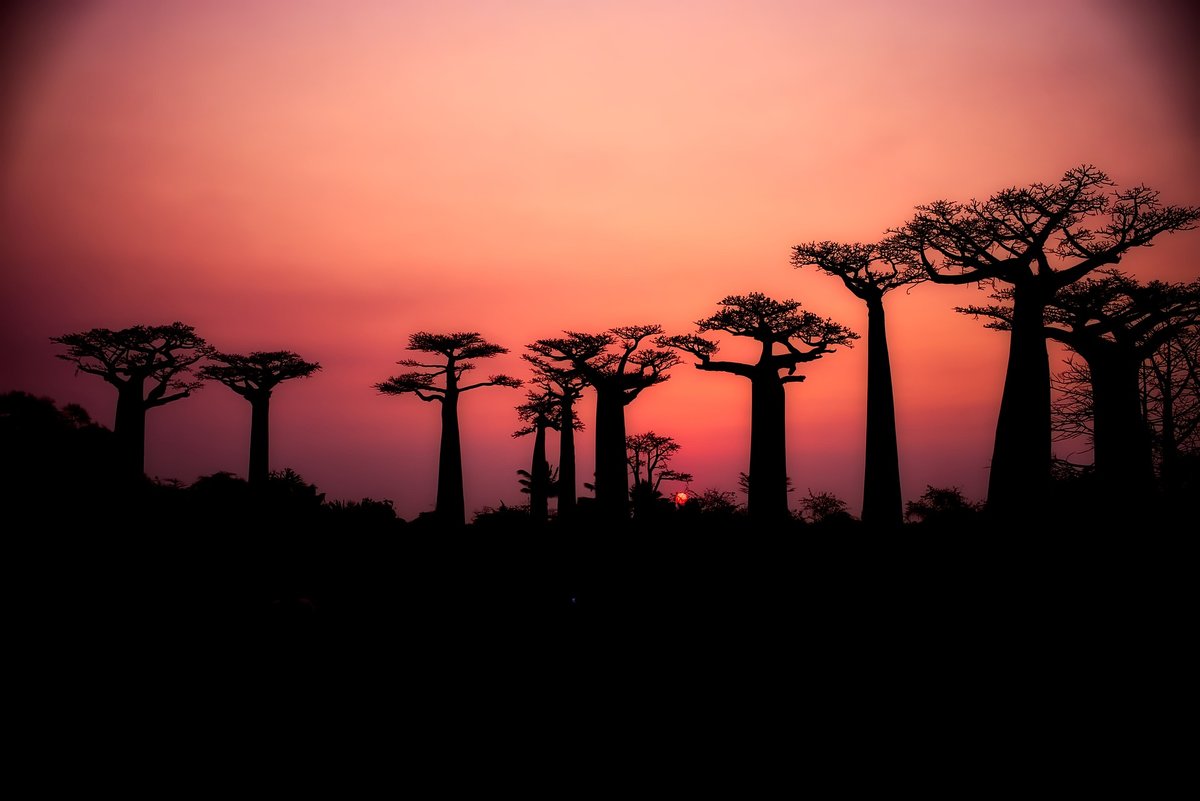
33 tips that will help you travel in Madagascar and make your time in this unique country so much more enjoyable.
Table of Contents
These travel tips are aimed to help you prepare for an unforgettable journey to this bizarre “ Red Island !” Written by an adventurer who’s spent more than a year in Madagascar, it’s the real deal.
The 33 recommendations below ( in violet ) are divided into 11 main sections ( in green ). This will make it easier for you to find the answers to a specific question.
HEALTH AND WELLNESS IN MADAGASCAR
Vaccinations to get before visiting madagascar.
- Visit a travel doctor well in advance. There are vaccinations you may need to be administered. These may take weeks to become effective. Refer to your vaccination records. Make sure you are up to date on the following: Typhoid, Hepatitis A, Hepatitis B, Meningitis, Polio, MMR, Tuberculosis (BCG) and/or Tetanus (DTP).
- You don’t need the Yellow Fever vaccine for Madagascar. However, if you plan to travel in mainland Africa on your way there, you DO need it. You will also need to provide proof of administration upon entering Madagascar if they see African countries stamped into your passport within the past 6 months.
Malaria Prevention
- You should discuss a Malaria prophylaxis prescription with your doctor. This is especially true if you are travelling between September and May. This is Madagascar’s warmer, rainier season.
- Take every day – tetracycline antibiotic.
- Pros : Least expensive, used to treat many bacterial infections (ex: urinary tract infections) and tick-borne infections. A double dose can be used to treat Malaria if someone in your group contracts it.
- Cons : Side effects may include sensitivity to the sun, increased likelihood of vaginal yeast infections, and weakened gut microbial health.
- Suggestions : Doxycycline is the prophylaxis I prefer. I just prepare for the side effects. I bring and use plenty of sunscreen and take probiotics to help my gut microbiome recover. Additionally, my doctor writes me a prescription for a burn cream (in case of sunburn), and treatment for yeast infections ( Fluconazole ).
- Take every day. It prevents the growth of parasites in red blood cells.
- Pros : Specific for malaria and also may be used for treatment.
- Cons : Relatively expensive. Its side effects may include mild stomach pain and diarrhea, headaches, difficulty sleeping, and vivid dreams.
- Take once a week. It prevents the growth of parasites in red blood cells.
- Pros : Don’t have to remember to take it every day.
- Cons : It. Has the most serious side effects. They include dizziness, severe anxiety, violent dreams, paranoia, hallucinations, depression. These nerve and psychiatric effects can sometimes last long after you stop the medication.
- Insect repellents. In addition to long pants/sleeves, they are the obvious methods of limiting mosquito bites. But they also help prevent flea bites. The bubonic plague is still present in Madagascar. It’s seasonal and rare but is transmitted through flea bites.
First Aid and Medications While Travelling in Madagascar
- You should have antibiotics , such as Ciprofloxacin. It will be useful in the event that you get a bacterial infection.
- If your burps begin smelling like sulphur and rotten eggs, you likely contracted Giardia parasites. Otherwise known as traveller’s diarrhea from contaminated water or food. Acquiring a Flagyl (metronidazole) prescription and taking this treatment once the burps start can prevent Giardia from becoming much of a problem.
- Useful over-the-counter medications – antibacterial ointment (ex: Neosporin / bacitracin), Anti-diarrheal drugs (ex: Imodium A-D / loperamide), allergy medication (ex: Benadryl ), anti-inflammatory drugs / pain relievers (ex: Ibuprofen ), antacids (ex: TUMS or Pepto-Bismol ) and rehydration tablets. Most cities will have pharmacies, but drug names and doses will likely be in French. It’s much easier to bring your own.
- You can never bring too much hand sanitizer ! Sometimes there won’t be soap available. Or you may make a bathroom stop on the side of the road. I also suggest rolls of toilet paper for the car. Our bodies aren’t familiar with the microbes in Madagascar. That makes it easier for us to get sick if we don’t remain mindful.
- Pack sunscreen and bug spray but check the ingredients list for harmful chemicals. If you’re planning to swim or snorkel in the ocean, please bring waterproof and “reef-safe” sunscreens that don’t include oxybenzone, butylparaben, or octinoxate that can bleach the corals!
- Menstrual supplies are limited and expensive in Madagascar. Women should bring their own.
Recommended Reading: The 33 Best Travel – Inspired Decor Ideas for 2021
Travel Insurance
- Invest in travel insurance. Be sure that it doesn’t just cover cancelled flights, lost or stolen items, and unexpected medical expenses. But also includes emergency medical evacuation . Madagascar’s road conditions are poor. And the health care isn’t generally what Westerners are accustomed to. Typically, being medevacked is your best option if it’s something serious.

TRANSPORTATION TO AND IN MADAGASCAR
Flights to madagascar.
- If travelling from the United States: Air France and South African Air are usually the best airlines to limit the number of layovers. However, I have also used Etihad Airways, Turkish Air, and Ethiopian Air. They typically cost significantly less money. However, expect multiple and longer layovers. Check out Skyscanner to compare prices.
- You will more than likely fly into Ivato Airport (TNR). It’s located 20 km north of the capital, Antananarivo (Tana).
- Air Madagascar is the domestic airline. It can save you a lot of driving time for long distance, internal travel.
Personal Vehicles in Madagascar
- If you don’t want to fuss with the scheduling and frequent discomfort of public transportation, it’s easy to hire a driver and guide for your entire stay.
- I don’t suggest driving yourself. However, if you have an International Driver’s License and nerves of steel, it’s possible to rent a car.
- You will not need a 4WD vehicle if you are going south on RN7. However, you will need a 4 wheel drive for travelling west on RN5 and north.
- Make playlists, download podcasts, charge your Kindle, and be ready to spend a lot of time in the car. Even though Madagascar is almost twice the size of the UK, it has only 1% of the paved road length that the UK has.
- Bring motion sickness medication , such as Dramamine (dimenhydrinate), if you have even the slightest tendency to get car sick! The roads can be quite twisty and bumpy.
- It’s not advisable to travel at night. Many drivers will refuse to continue much past sunset. Listen to your drivers. Bandits only strike at night for the most part.
Recommended Reading: Indian Decor That Will Make You Feel Like You´re Travelling in India
Public Transportation in Madagascar
- Hired Taxi – like most cities across the globe, there will always be a taxi cab eager to assist you. The fare is negotiable and you should haggle. The taxi drivers are known to charge tourists highly inflated rates.
- Taxi-Brousse are large vans with designated routes to almost anywhere in the country. They are the least expensive method of getting around. However, they generally aren’t comfortable, efficient, or particularly safe. It’s not uncommon to end up with a child or chicken in your lap. And if you’re carrying anything larger than a backpack, it will be tied to the roof.
- Taxi-Be are almost identical to taxi-brousse, except taxi-be is the term used for the organized minibusses within major cities. Whereas taxi-brousse are generally used for travel between cities.
- Cotisse – a transport company with minibusses similar to taxi-brousse. However, it’s higher end and much more comfortable. They always leave when scheduled instead of waiting until the car is full and packed. They also drive more carefully. And if you’re really lucky, you can connect to free WiFi.
- Trains – there are over 1000 km of railroads tracks in the RNCFM Malagasy rail system. But it’s primarily used to transport cargo. There are only 6 routes with passenger trains. While travelling by train in Madagascar is a lovely way to see the country, they run notoriously late.
- Cyclo-Pousse – a covered rickshaw cart fastened to a bicycle. They’re used in most major cities (though, not the capital). Pay the bike ‘driver’ a small fare (Ar 5000 or less), and they’ll bring you to your destination. With frequent traffic jams in major cities, they are often faster than a car .
- Tuk-Tuk – motorized three-wheeled rickshaws that hold three people and are almost always yellow. It is usually a flat fare, but the prices are quite reasonable (similar to cyclo-pousse).
- Charette – a wooden cart pulled by zebu cattle is the most common way of getting around in rural areas. There is no set price. Haggle for what you are willing to pay.
- In some coastal areas, especially the southwest and the northeast, the primary means of transportation is by cargo boats. Avoid them during rough seas and cyclone season (Jan-Mar).
Dugout canoes called pirogues are common for crossing rivers or for getting to the best snorkelling areas.
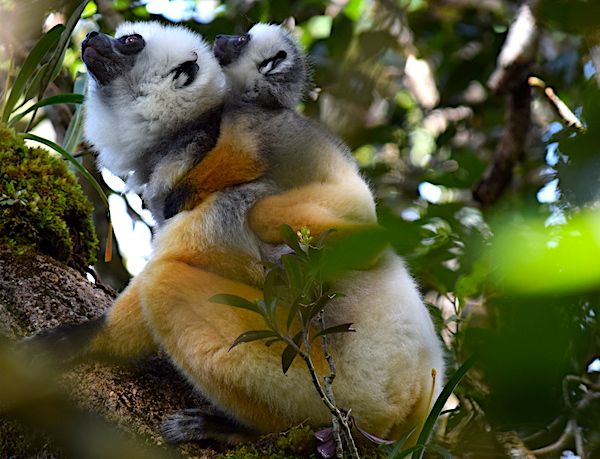
8. Flexibility is KEY When Travelling in Madagascar
Please remember to be flexible, patient, and respectful to your drivers and other Malagasy people you encounter.
Most Malagasy don’t like rushing. And in a country with limited resources, it’s easier to just go with the flow .
The Malagasy have a saying, “Mora Mora,” which translates to slow living and no worries.
They are going to be relaxed, and I promise that you will have much more fun if you relax too!

FOOD AND WATER IN MADAGASCAR
Filtered water.
- Lifestraw Go water filter bottles are legitimately a life saver. Especially if you are environmentally conscious or an avid hiker. If you don’t want to constantly be buying water bottles, you can fill your LifeStraw up with unfiltered tap water. Or if you’re on the trails … anywhere !This allows you to avoid starting hikes with 3+ litres of heavy water. I have even filled my Lifestraw in a warm and murky rice paddy during desperate times. I never felt any signs of sickness. Lifestraws are relatively prone to leaking and should be kept upright. But they are 100% worth the small investment!
- Avoid ice in your drinks unless you can guarantee that it was made with filtered water.
Food and Drink in Madagascar
- Sometimes there isn’t much variety in the cuisine. On the plus side, meals come at a fantastic value! The capital – Antananarivo – and touristy areas, especially along the coasts, will have more to offer. I’ve had some of the best meals of my life in Madagascar. Just be flexible during monotonous periods.
- Like with ice, avoid uncooked vegetables unless you’re certain they were washed with filtered water.
- I encourage everyone to try the “Ranonapango.” It’s essentially burnt rice tea. Although it’s not actual tea, it’s comforting and reminds me of popcorn… Rice is the cornerstone of the Malagasy diet. It’s the base of every meal, including breakfast.
- “Toka-gasy” is a Malagasy moonshine made with sugar cane. You could be offered a drink by a village King. It’s considered rude not to accept. However, do be aware that it is technically illegal. Though, not enforced because the alcohol content cannot be controlled. Some batches seem weak and others will knock you on your feet!
- It’s a good idea to bring protein bars . Especially if you have dietary restrictions (such as vegetarian or vegan) and/or plan on long hikes.
- Here’s some additional info on local food and what to expect.
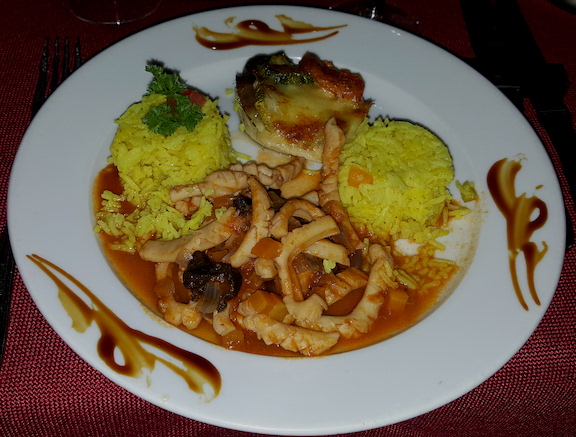
LANGUAGE IN MADAGASCAR
- Brush up on your French. Madagascar was once a French colony. French is still one of the official languages.
- Many signs and restaurant menus will be in French.
- Most prices will be told to you in French. It will be beneficial to at least learn your numbers .
- Try learning simple Malagasy phrases. The locals sincerely appreciate when you invest time and interest in their native language. For starters, “ Salama ” means hello. “ Veloma ” means goodbye!
- Malagasy people are more inclined to be open and friendly with people who aren’t from France. So don’t feel like you should become fluent in French!
- There are a few Malagasy/English handbooks available if you’re interested in languages. Malagasy is a tough language to learn until you’re immersed, especially the pronunciations! This short video of a few keywords in Malagasy with pronunciations will get you started.
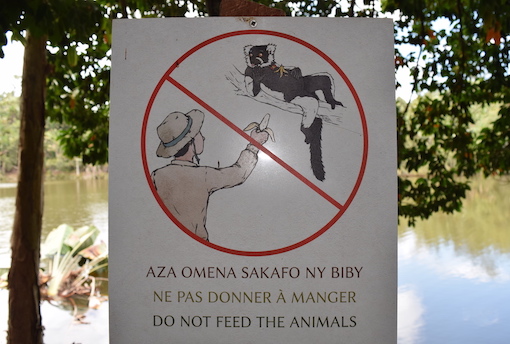
MONEY IN MADAGASCAR
Malagasy currency.
- The currency in Madagascar is called Ariary (MGA)
- Ar 4000 = 1 EUR
- Ar 4600 = 1 GBP
- Ar 2500 = 1 AUD
- Ar 250 = 1 ZAR
- The largest bill – Ar 20,000 – is equivalent to less than 6 USD. However, it’s considered substantial to most Malagasy. You’ll want a safe money bag or belt because you will be carrying many more bills than you are used to.
- The Ariary notes changed in 2017. Therefore, there are two designs for every bill, excluding the Ar 20,000. The Ar10,000 was the largest bill until 2017.
Access to Cash and Using Credit Cards in Madagascar
- To exchange your currency into Ariary, bring relatively large and new bills. They shouldn’t be older than 2010. It will be easiest for you to exchange your currency right at the airport. That way you’ll avoid the long lines and limited hours of banks. I find this to be the easiest way to access money.
- Credit and Debit cards. Some places in cities accept cards, but only VISA is reliable. Other networks like MasterCard and AmEx often won’t work. Honestly, it is best to carry cash !
- ATMs are only available in big cities. And there’s a limit to how much you can take out. Also, it’s not uncommon for ATMs to be out of order or empty.
Begging in Madagascar
- You will have people begging you for money. Especially children, mothers, the elderly, and the disabled. I would be lying if I said it wasn’t difficult to witness. But it’s unavoidable, especially in big cities.
- Everyone is entitled to their own opinions on how to handle these situations. But do acknowledge that your actions will impact more than just the beggar. Begging is not a sustainable way to make a living.
- If you decide to give, be tactful about it. Don’t flash large wads of cash. And understand that successful beggars often return with friends. To avoid being surrounded and causing a scene, wait until you are about to get back into your vehicle.
- I generally only give to those performing – sometimes people sing, dance, or play an instrument. And I never give to overly pushy people. I don’t want them thinking that’s the way they should approach all tourists.
- When giving money, I keep it discrete and politely urge them to use it for food.
Tipping in Madagascar
- Tips are generally well received and deeply appreciated. They’re sometimes it’s your biggest daily expenditures. Especially if you’re on a guided tour where most expenses are paid for ahead of time.
- When you can break large bills into smaller bills for tipping. Keep these tips in a separate pocket from the majority of your cash.
- To offer you a perspective, Malagasy people who are fortunate enough to be employed typically don’t make more than Ar 200,000 (~$56 USD) a month .
- If you want to keep your tips within the average range of other tourists, roughly follow the guide below. However, you are welcome to give more. Especially with guides and drivers. But only if they exceeded your expectations.
- Taxis and bars : Not expected or small bills.
- Porters : small bills, likely not over Ar 1000.
- Restaurants : 5% of the bill or less.
- Guides : 10% of the fee.
- Personal Drivers : Ar 5000 – Ar 20000 a day.

PACKING FOR MADAGASCAR
- Bring more warm clothes than you would think necessary. This includes thermals, hat, gloves, and fleece. Especially if you are travelling during Madagascar’s winter months (May – September).
- However, the climate throughout Madagascar changes rapidly . While the cool rainforest fog may send shivers down your spine in the morning, you can jump in the car and find yourself in a desert ecosystem by late afternoon. Therefore, you will want to pack a variety of clothing. Be sure to bring shorts, T-shirts, and durable sandals.
- If you plan on hiking , you should pack quick-drying field pants, sturdy hiking boots , wool socks, a baseball cap, and a rain jacket. While hiking in rainforests, I advise tucking your pants into your socks and your shirt into your pants to minimize leech bites. Leeches don’t transmit diseases, their bites don’t hurt, and they only remain attached for about half an hour. However, they do have an anticoagulant in their saliva. This causes you to continue bleeding even after they drop off. And these bites can itch worse than mosquito bites. Take precautions but don’t panic if you get a leech.
- I also recommend a substantial daypack with a supportive waist belt and chest strap. This could double as your carry-on luggage for the flight!
- Don’t forget bathing suits ! Beaches aren’t the only places to swim; some parks have natural swimming holes you can hike to.
Travel Documents For Madagascar
- Your passport cannot expire within 6 months of entry and must have at least 3 blank pages. They are strict about this!
- Carry your immunization records. They may not be requested if you haven’t been in countries with Yellow Fever.
- If you’re travelling with a large group, it’s beneficial to obtain your Madagascar VISA within your home country. Otherwise, it’s easy to purchase a tourist VISA upon arrival at the airport for 30, 60, or 90 days.
- I prefer to have paper photocopies of my passport and tourist Visa. The police will occasionally ask to see your passport, especially in cities and on the road, but I don’t like carrying it wherever I go.
Power in Madagascar
- Bring European plug adaptors if necessary: 220 Volt, 50Hz AC (Two circular metal pins).
- Charged power banks are invaluable, especially considering the amount of travel time. If you need your phone to stay alive for the entire day, I would bring a power bank or two.
General Equipment
- Pack binoculars for lemur and bird watching! If you’re concerned about them occupying souvenir space in your suitcase, donate them to a deserving park guide near the end of your journey. Malagasy guides are often in need of functioning binoculars.
- Bring a bright headlamp and/or flashlight for night hikes. There are nocturnal lemurs, chameleons, frogs, snakes, geckos and so many other creatures you don’t want to miss!
- Wristwatches are convenient for checking the time. I t might not always be a good time to pull out your phone.
- All sizes of Ziplock bags are precious. Smaller bags can organize your medications and chargers; medium bags can keep your electronics and books dry; large bags are perfect for wet or dirty laundry.
- I recommend silica gel packets and dry bags for your electronics and camera if you’re spending an extended time in humid, rainforest environments.
- Remember the items mentioned in previous sections : medications, hand sanitizer, sunscreen, LifeStraw water bottle , protein bars, bills to exchange, designated money bag, VISA credit/debit cards, etc.

THINGS TO BE MINDFUL OF IN MADAGASCAR…
Internet and phones.
- Most hotels have complimentary WiFi. However, even luxury hotels don’t always have internet or outlets in individual rooms/bungalows. Sometimes you have to sit in the reception area for internet access and charging. WiFi is available in some restaurants, but you will need to ask for the password.
- If you have an unlocked GSM cellphone, you may want to buy a local SIM card (Airtel, Orange, or Telma) and a 3G package. You can do this at the airport. If you don’t want to purchase a plan, you can buy phone credit at virtually any shop.
Cultural Awareness in Madagascar
- Avoid pointing with only your index finger extended. While it’s not considered offensive everywhere in Madagascar, it’s better to be safe than sorry. Pointing with your index finger is considered a “ fady ” or taboo in many regions of Madagascar. Especially when pointing directly at a tomb or grave. You can either gesture with your whole hand open, or bend your finger as you point.
- It is expected to haggle prices unless the price is already established, such as in tourist shops, restaurants, and hotels. It’s part of the culture.
- It’s respectful to dress fairly modestly . You’ll see everything in tourist areas. However, I personally avoid low cut tops, short skirts and shorts. And I only wear one-piece swimsuits.
- While difficult to ignore their puppy-dog stares, don’t feed street dogs . Malagasy people can view it as highly offensive that you took the time and money to feed a dog, but not their family.
- Most Malagasy actively avoid confrontation, especially with foreigners. Don’t take advantage of this.
Saying “Thank You” in Madagascar
- In Malagasy, “ Misaotra ” means thank you. Add “betsaka” if you want to say, “thank you very much.”
- If you anticipate any village visits, a gift that would be appreciated by everyone is a high-quality soccer ball . I always bring several deflated soccer balls and an air pump from the States.
- You’ll probably become close with your driver and guide. In addition to a tip, you may want to thank them with foreign gifts . A T-shirt representing your city or country, candy from abroad, or something else they wouldn’t find in Madagascar are the most cherished gifts.

PHOTOGRAPHY IN MADAGASCAR
Keep your camera close.
- If you have a DSLR camera, keep is safe, but don’t be afraid to bring it . There are countless sites and creatures to document that small cameras and phones just can’t capture.
- Keep all valuables close, especially in big cities like the capital of Antananarivo (Tana). I wouldn’t worry about being attacked. However, there are some skilled pick-pocketers. They can swipe your cash, phone, or other items without you even noticing.
- Just as you would back home, ask before taking someone’s picture. If you don’t speak French, saying “ Sary? ” (pronounced similarly to the English, “sorry”) – which means “Picture?” in Malagasy, should sufficiently get the point across.
- Adults will occasionally wave you off, but kids love to pose. You should show them their picture. But remember to wipe down your camera with a disinfectant afterward. The kids may excitedly grab your camera for a closer look with their cute, but dirty little hands.
Selfies in Madagascar
- NEVER pay to take pictures with wildlife kept at restaurants or hotels.
- Paying for these photos encourages the illegal and devastating pet trade. One of the reasons lemurs are endangered .
- Many of these animals, especially lemurs, don’t survive these conditions. If they don’t die from a poor diet, they may be killed when they display aggression as they become sexually mature. The “Magic of Madagascar Ecotour” will take you to one of the only rescue centers in Madagascar that confiscates pet lemurs and teaches them how to survive the wild.

SOUVENIR SHOPPING IN MADAGASCAR
Avoid purchasing….
- Carvings made from precious woods like Rosewood and Palisander
- Butterflies and other preserved insects
- Sea turtle shells
- Sapphires, other precious gemstones, and gold
28. Ethical Shopping
- Aim for sustainable gifts that don’t negatively impact wildlife or people while simultaneously expressing Malagasy culture.
- My main suggestions include… hand-dyed and spun silk scarves woven from sustainably farmed silk, items made out of recycled aluminium, and art constructed from repurposed zebu horns.

EXCLUSIVE TRAVEL EXPERIENCES IN MADAGASCAR
Places to visit in madagascar.
- RN7 is your best friend. This route starts at the capital and works its way south, then slowly west. It is accessible year-round and brings you through every incredible ecosystem Madagascar has to offer! That’s the route that we take on our Ecotour through Madagascar from July 1st – 12th, 2019!
- RN5 takes you west to see the “ Alley of Baobabs ” or possibly even the limestone forest of Tsingy ! This road is more difficult to navigate. It’s comical that it can even be considered a national route.
- The north is also beautiful, but similar to the west, the roads are very poor, especially as you work your way west.
- There are stunning places that are easiest to fly to, such as the rainforest peninsula of Masoala and the island of scuba-divers dreams – Nosy Be .
30. Wildlife You CANNOT Miss in Madagascar!
- “The Magic of Madagascar Ecotour” brings you to the largest species of lemur (indri) and the smallest lemur (mouse lemur), with many lemur species and sizes in between!

If you love Madagascar as much as we do, you’ll love our lemur t-shirts:

This meditating lemur t-shirt is the perfect gift for the animal lover in your life whether it be your wife, husband, sister, brother, best friend, son or daughter. It looks great with jeans and is perfect for a casual day out.

This t-shirt with words about lemurs is perfect for animal lovers – who want to show their love for ring-tailed lemurs and to raise awareness about this endangered species – see how many words related to lemurs you can find.
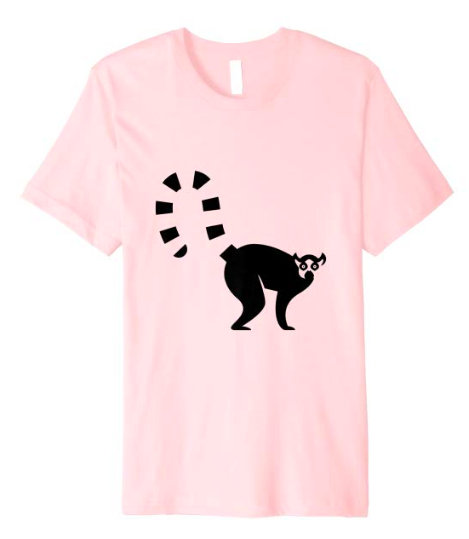
This ring-tailed lemur t-shirt will be a hit with animal lovers who want to show their love for these unique creatures while raising awareness about these critters from Madagascar who need our help.
ADDITIONAL MADAGASCAR INFORMATION
- Films and Books about Madagascar
- If you are keen to learn more about the creatures and culture before going or booking a ticket to Madagascar, I recommend either of the following films : Planet Earth II (on Netflix) and Island of Lemurs: Madagascar (IMAX) .
- Additionally, I recommend the following books : For the Love of Lemurs (Patricia Wright); Thank You, Madagascar (Alison Jolly); The Aye-Aye and I (Gerald Durrell); and Madagascar – The Eighth Continent (Peter Tyson).
- Field Guides for Madagascar
- There are good field guides available for most taxonomic groups in Madagascar. I have personally had the best luck with Lemurs of Madagascar: Third Edition and Birds of Madagascar and the Indian Ocean Islands . Note: if you can’t find that check out Lemurs of Madagascar: Tropical Field Guide Series .
- For travel guides, the Bradt Guides are probably the best guide I have come across. The author has been travelling to Madagascar for over 30 years! The Lonely Planet – Madagascar: 8 th Edition is also quite thorough.
- Online Info on Travel in Madagascar
- While this article provides a comprehensive list, you can’t fit everything into a single post! I recommend perusing additional online resources that can provide even more information about Madagascar. Be sure to check out 28 Interesting Facts About Madagascar !
- Continue researching and reading! The more you know, the better you can prepare for culture shock. And the more you will appreciate all the sights, sounds, smells, and tastes of Madagascar!

The long-ground roller is a bird species endemic to the spiny forests of Madagascar; Photo: Alicia Lamb.
Best of luck with your travels in Madagascar! Take care and enjoy, or as they say in Madagascar, “Mazotoa!”

1 thought on “Madagascar Travel: 33 Things You Need to Know Before You Go”
I love your detailed and comprehensive post! Saves us the time to research about do’s and don’ts around Madagascar. Interesting pictures as well – “Michelangelo’s Creation of Adam” moment tickled me. 😀 Saving this for later!
Leave a Comment Cancel reply
- BOAT OF THE YEAR
- Newsletters
- Sailboat Reviews
- Boating Safety
- Sailing Totem
- Charter Resources
- Destinations
- Galley Recipes
- Living Aboard
- Sails and Rigging
- Maintenance

The Magic of Cruising Madagascar
- By Amy Alton
- Updated: July 14, 2021
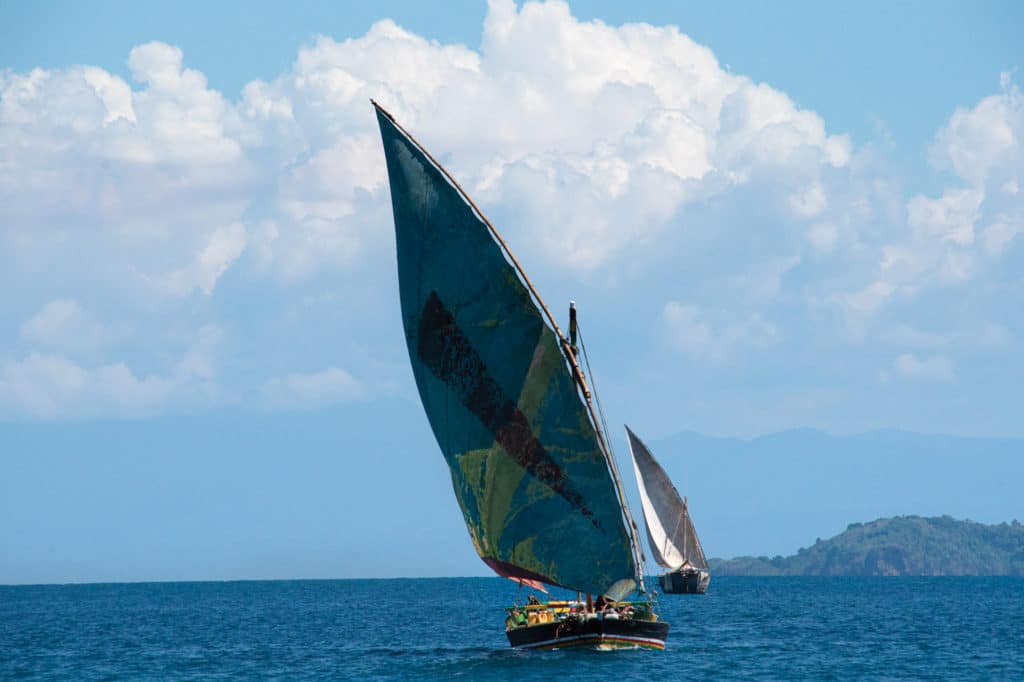
“Plongée,” the man in the canoe said to me.
I flipped through the pages of my French sailor’s dictionary, hoping to stumble upon an explanation of what this man wanted. It had been years since we were in a French-speaking territory, and I was woefully unprepared to figure out he was talking about diving.
But I was motivated. In his small little dugout canoe was my prize for a successful negotiation: two large spiny lobsters and a moderate-size grouper. We had stumbled through delivery negotiations the day before.
“Langoustine?” he had asked me.
He held his hands up: big or small?
And then fingers: one, two, three?
He nodded and sat in his canoe.
“Poisson?” I asked him.
And there we were, 12 hours later, and all that stood between me and a seafood extravaganza was my horrible French. I had no ariary, the local currency, and when I offered euros, he shook his head.
I stepped inside our 44-foot catamaran, Starry Horizons , a Fountaine Pajot Helia, and pulled out a few items from a designated “trading” bag. Prior to our arrival in Madagascar, cruising friends who had come before had advised us that the Malagasy people prefer trade over commerce.
I handed the man a few items, which he looked over—some he kept, some he gave back. “Plongée,” he said again, tapping an open hand on the surface of the water.
Finally, I pulled out a snorkel mask, and he became excited. With a big smile, he accepted the mask and handed me over his catch.
I was proud of myself; it was our first morning in Madagascar, and I’d just had a successful interaction with a local and acquired some delicious seafood.
My husband, David, and I had come over the top of the island from the Seychelles, a passage that had taken us a little less than four days, and the previous night had been a whopper. Cap d’Ambre had proved to be challenging, with the swells and currents hitting us in the black of night. Starry Horizons climbed up waves, barely making any speed over the ground, before surfing down the other side at 10 knots.
We’d hastily thrown on both engines and cut toward the shore—land that we couldn’t see under the cover of clouds and a new moon. The chop and wind lasted longer than we thought it would, even while trying to tuck in along the shore to get under its lee. Finally, we dropped anchor at Nosy Mitsio, a small island off the northwest coast, where we were well-protected and not alone; three other cruising boats were in the anchorage just off the village.
This was our first true glimpse of Madagascar. It was dry and brown with sparse vegetation, and cows—or maybe zebu, the horned and humped cattle— wandered along the shore.
Since we hadn’t officially cleared in yet, we rested and moved on quickly, taking a day to sail down to Nosy Be, the hub for sailing activity in Madagascar, and one of the busiest tourist centers in the country.
Madagascar , once known at the Malagasy Republic, has always intrigued me. Even before other sailors had told me that the island nation was on their list of favorite places, I pictured it as an opportunity to explore a world completely different from my own. We were on the home stretch of our own circumnavigation, and had been to many places where the cultures were vastly different from ours. But these places didn’t seem as authentic. For instance, tourists flock to Thailand by the millions (35 million in 2017), whereas Madagascar, only slightly larger than Thailand, saw fewer than 100,000 tourists in the same year.
There’s a reason: It’s hard to get there, and once you reach the former French colony, travel within the country is a challenge too. A majority of the roads (some estimate 90 percent) are unpaved and wash out during the rainy season. Trains and buses are cheap but cramped and unreliable.
Travelers can overcome these difficulties by visiting Nosy Be, however. It’s a small island on the northwest coast. Direct flights arrive from Europe, bypassing the capital, Antananarivo, and there are a variety of activities available when you get there, whether as a tourist or cruiser.
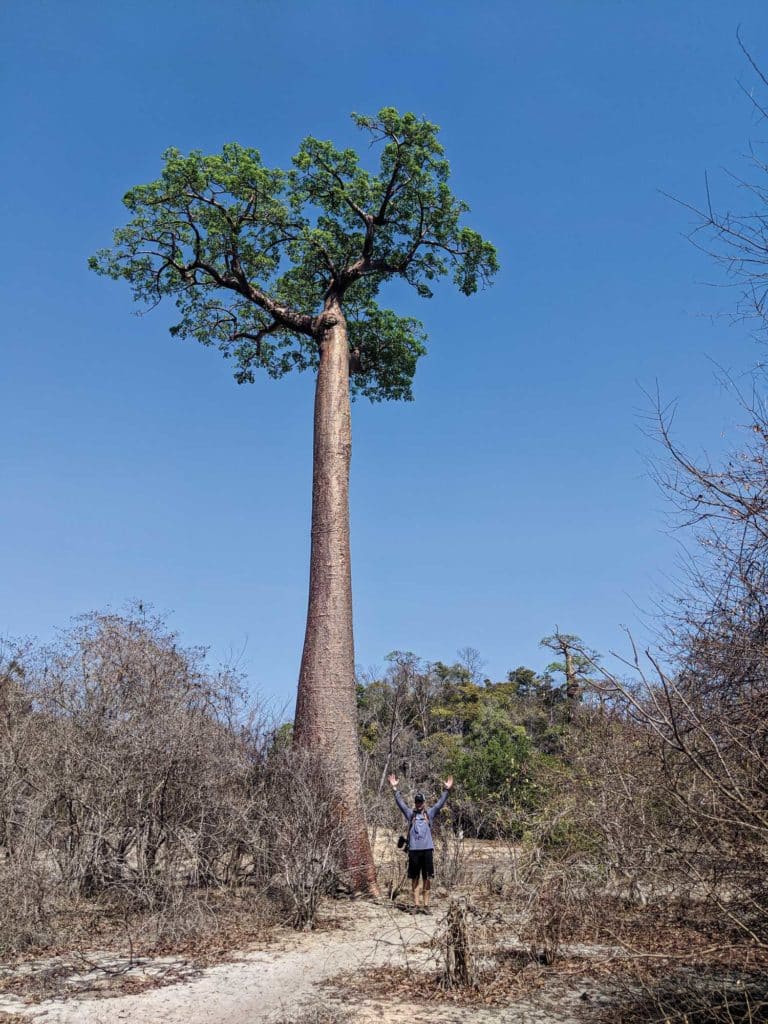
Touring the Town
We arrived at Hell-Ville, the capital of Nosy Be, with vague advice from friends to “find Jimmy with the red hat.” And despite the thick traffic of tour boats, ferries and traditional Malagasy dhow fishing boats, we did find him. It turns out that he’s at the dock every morning keeping an eye out for the few sailboats that wander into Hell-Ville’s unattractive port to complete their formalities.
Jimmy spent all day with us. We visited the required offices, paid fees and filled out paperwork. He took us to the ATM, where we stuffed our wallets full of 20,000 ariary bills, each the equivalent of $5 back home in the US. With our newfound cash, we bought a SIM card, connected to the internet, and then hired a tuk-tuk to take us shopping at a store called Shampion, which was stuffed with French imports. I had thought that Madagascar would be one of the harder places to provision based on its economy, but happily, I was wrong; the shelves were full of Western foods.
Besides Bio- and Carrefour-branded items, I found Tsara Malagasy dark chocolate. At no other time in my life have I experienced such a startling departure from a familiar taste. Malagasy chocolate is rich and fruity, made of a bean variety rarely grown elsewhere.
Next, Jimmy took us to the Hell-Ville Market, a building stuffed to the gills with local food. I bought small shelled peanuts, roasted and salted to perfection; smoked and dried bananas that are ubiquitous to French territories; and giant, succulent Malagasy tiger shrimp, caught that morning by the local fishermen. (I avoided the red hunks of zebu meat that were sitting out and covered with flies.)
When our day with Jimmy was done, we’d paid officials over $200 to visit Nosy Be. Without negotiating, we also paid Jimmy his requested fee, a paltry amount for spending the entire day with us. We’d done the same with our tuk-tuk driver and at each stall at the market. The prices were low, the economic gap wide, and I gratefully handed over the fees.
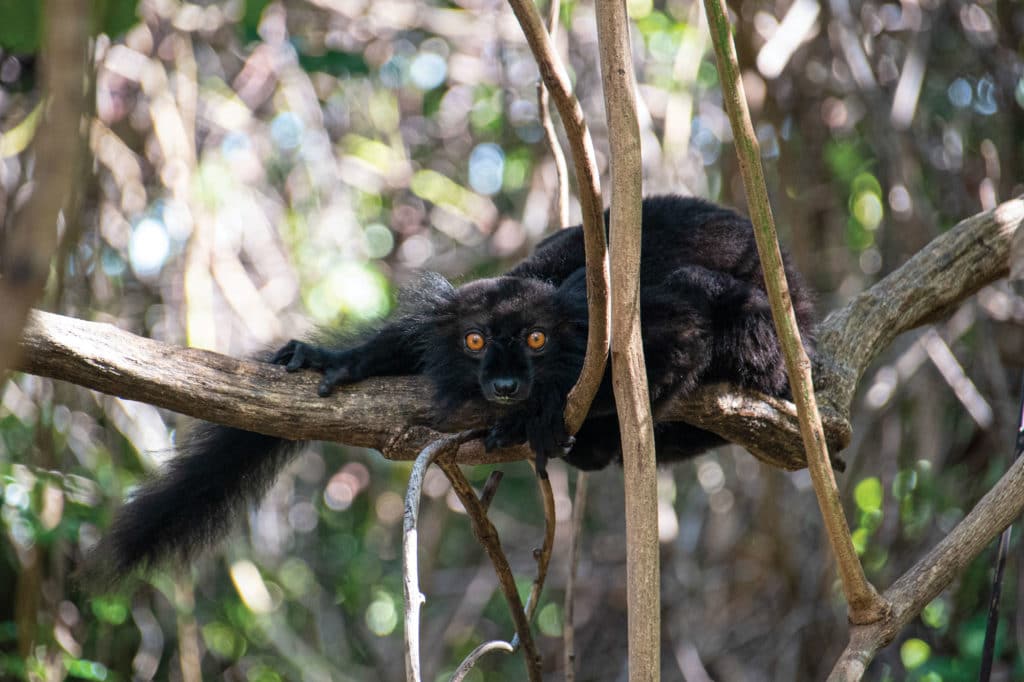
Settling In
Sailors in Madagascar learn to time their days with the breeze: offshore in the morning, onshore in the afternoon. In between, it’s either dead-calm or the breeze is light. We chose afternoon to move to Nosy Komba, an island 6 miles southeast of Hell-Ville. We raised sails and coasted along in 7 knots of wind, dodging the traffic in and out of Hell-Ville. By sunset, we were anchored on the northeast side of the island, fairly unprotected from the swell but next to our buddy boat and friends Kimi and Trevor, who had been in Madagascar for more than a month.
In the morning, the four of us went to the park-ranger office in the village and hired a guide to take us on an ambitious trip to the top of the island. Our ranger, John, grabbed a fistful of bananas before we started the climb.
As we walked, John told us about the local village, and we passed through stalls where women sell hand-carved wooden lemurs or traditionally woven linens. Most were unattended because it was still early.
John stopped us. “Look,” he said, pointing to the tree. “We have company.”
Climbing through the branches were lemurs. The females—the bosses—were brown; the males, black.
“Stand right here,” he directed me, “and turn around.”
A moment later, I was startled when a small weight hit my shoulder from behind. My cheek brushed against delicate fur, and out of the corner of my eye, I saw an inquisitive face and a paw reaching out for John’s offered banana.
We all took turns standing by the tree as lemurs leaped onto our heads, shoulders or backs, and climbed down our arms. They were lighter than we expected, and softer. Several of the females had babies clinging to their bellies, with large round eyes staring at us.
When the bananas were gone, so were the lemurs.
“In the rainy season, when the fruits are ripe, they don’t come to feed with us. There’s too much good food for them in the trees,” John told us as we continued on up the path.
Then John stopped us again five minutes later. He pointed to a small tree just to the left of the trail, and I strained my eyes trying to see what he saw. As happens when viewing an autostereogram, my eyes adjusted, and a chameleon appeared in the leaves before me. And then I saw them everywhere. The others saw them too, and we watched their tall but extremely narrow bodies as they slowly, haltingly climbed the branches.
As we climbed, we saw a ground boa, various lizards and insects, and we passed a religious memorial and cemetery for French soldiers. At the top, overlooking Nosy Be, we found a bamboo shack on a manicured plot of land. The lawn was dotted with picnic tables and the view was spectacular, the flat-calm waters around the islands reflected the clouds above. At the shack, a young man sold beverages. John ordered a hot lemongrass tea, while the rest of us asked for cold lemon juice; Trevor got his with a shot of local rum.
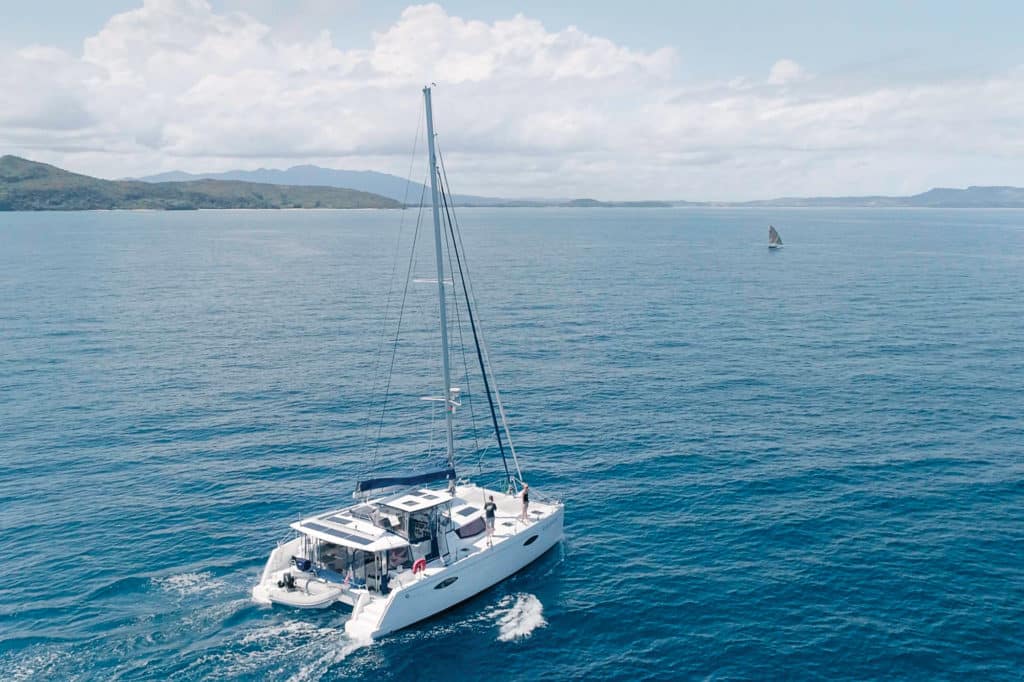
Dhows and Dugouts
Back in Nosy Be, we anchored in Crater Bay off the yacht club. In the morning, we sipped our wake-up beverages and watched the local fishermen. All day, every day, they paddled by in dugout canoes to lay out fishing nets before hauling up shimmering silver fish by the hundreds. Meanwhile, traditional Malagasy dhows glided around us, with their patched sails making use of the light winds.
“What exactly are we doing on the tour today?” David asked me.
I shrugged. “I’m not sure. Lokobe Park, I think?” It’s the top attraction in Nosy Be, according to Trip Advisor, which meant we could expect an adventure.
Our guide, Achim, picked us and Kimi up at the yacht club, and we headed off to the other side of the island. The road was mostly unpaved, and our big van bumped along, passing men and zebu plowing fields together, and ylang-ylang trees bowing down in vast groves.
In Ambatozavary, a small village, Achim changed out our driver for one of the men from the village, a local guide named Joe. It seemed as though the whole village was there, and everyone walked down to the beach, through the mangroves and mud, to where outrigger canoes were anchored. The local school children stripped down, swam out and brought in the boats.
Joe and Achim instructed us—the only tourists—to climb into a canoe, and Achim handed us a paddle. We set off before the other boats were loaded.
After 20 minutes, I asked Achim, “How far are we paddling?”
He pointed vaguely out over the horizon. “Across the channel.” The next island was more than 10 miles away, and I was glad I’d kept up a workout routine while sailing.
We took turns paddling, but Joe and Achim were our ringers, rowing strongly and steering us around the reefs. Before long, boats started to fly by; not just the outrigger canoes we’d left behind, but also small powerboats with tourists. Some even towed canoes behind them.
To our relief, our guides steered our canoe to the beach after about 45 minutes—our destination was not the distant island. We disembarked and set about exploring the Lokobe National Park. Joe led us on a walk through the forest, where we spotted tree boas, leaf-tailed geckos and more lemurs. These lemurs were feeding on jackfruit, sticking their heads into the insides of the fruit from beneath and feasting.
When we returned, lunch—a variety of Malagasy dishes—was prepared: green mango salad, crab curry, and bananas cooked in coconut milk. When the meal was over, we were given time to wander through nearby handicraft stalls selling ylang-ylang oil, carved wooden lemurs and traditional woven linens. Then it was back to the outrigger for our paddle back.
To finish our day, we took the easy walk to the top of Mont Passot and watched the sun set over the crater lakes. Sunsets in Madagascar were exceptionally beautiful. The air quality was clear, and we could see mountains 50 miles away as the sun turned a deep red and dropped behind the islands.
We had one last adventure in store for us in Nosy Be. With our other cruising friends Carlos and Linda, we hired a dive shop to take us out to look for whale sharks. David and I have tried, unsuccessfully, to swim with them for years in various places around the world, and this time, we were exceptionally lucky. Our captain pointed the motorized outrigger toward open water, and a young boy climbed up on the bow to spot. The boy scanned the surface of the water looking for schools of jumping tuna. Whale sharks don’t eat tuna, but the tuna feed on smaller fish, which, in turn, feed on plankton. Where you find leaping tuna chasing their food, you’ll find whale sharks too, basking and sweeping up the plankton in their wide mouths.
We spotted the first school of tuna and approached. A whale shark was just below the surface of the water, and with the crystal-clear view, we could see his constellation-riddled hide. After all, the Malagasy name for whale sharks is marokintana, which translates to “many stars.”
“Go,” our guide said quietly, and we slipped into the water less elegantly than we’d have liked. The shark floated diagonally, its mouth on the surface while surrounded by beams of sunlight. It tolerated a few moments of our attention but then moved on.
Our guides had a tough job trying to predict where the whale sharks would be found. They tried to drop us in the water where we wouldn’t disturb the fish too much, but also near where they expected the whale shark to swim in order to maximize our time with each one. By the end of the day, we’d been in and out of the water dozens of times, and some whale sharks approached close to inspect us, while others veered off quickly. We were euphoric, having finally taken that amazing swim we’d dreamed of for years.
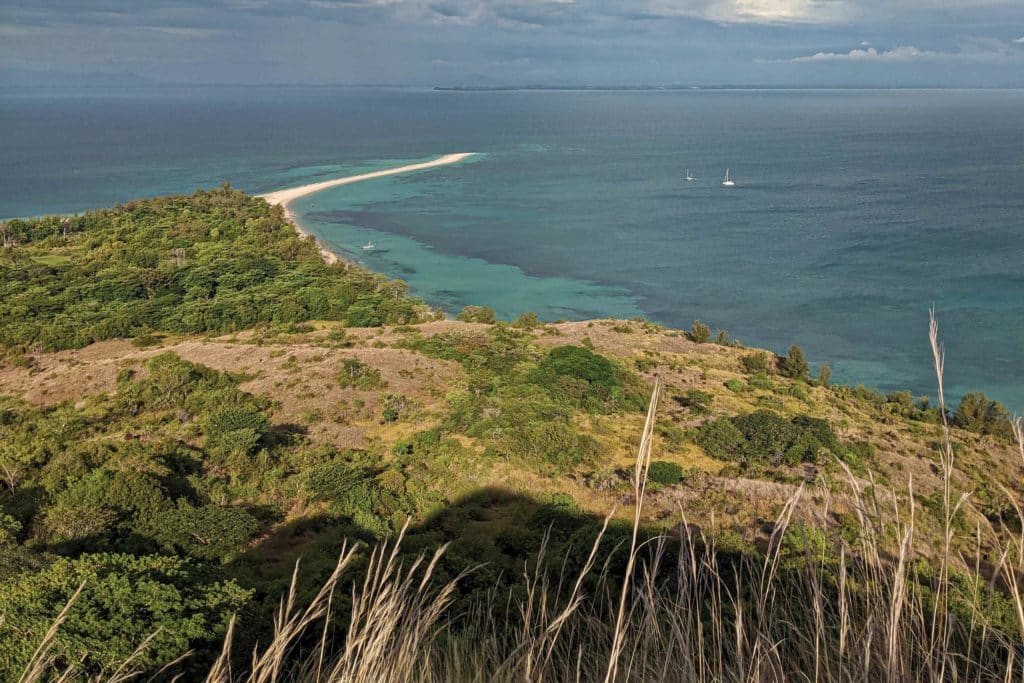
Our time in Nosy Be had come to an end. We had an ambitious few months ahead of us: crossing the Mozambique Channel and sailing around South Africa. As do most cruisers, we made our way down the west coast of the big island, ducking into protected waters and making progress toward the narrowest part of the Mozambique Channel.
The sailing was an exercise in frustration. The morning wind was light and from forward of the beam. It died midday, then picked back up again from the opposite direction.
When we arrived in Honey River, only our friends Carlos and Linda were there, but as the day progressed, the charter boats filed in. Still, there was plenty of room for everyone.
A small village sits on the north shore, and it was possible to buy the namesake honey there. I went ashore with Linda, who speaks French—a good thing because the locals didn’t speak English. At one shop, we agreed to the price, and the woman started to fill our jars with honey from a jerry can. Around her sat a collection of 1.4-liter plastic bottles of honey, which I belatedly realized were a better price. But our deal had been struck.
She poured the sweet liquid into my jar through a sieve, and when it was full, she lifted the sieve and licked the drop of honey off the bottom before placing it in a bin. There were certainly no health inspectors around!
Linda and I visited the library and donated school supplies. The kids swarmed around us. They are used to cruisers and charter guests popping in with gifts, and they have learned to be persistent. They asked for books, candies, even the hats and sunglasses off our heads, and we eventually had to shoo them away. Honey bought, donations made and village explored, we returned to our boats.
Our next stop, with Carlos and Linda following, was the beautiful island of Antanimora. This is typically the last stop for charters, and for some reason, when we arrived in the afternoon, the vacationers were all anchored on the north side of the little sand spit that stretches out at low tide. The wind blows from the north later in the day, so they were experiencing a rigorous chop. We ducked under the south side of the spit, and even when the wind shifted in the morning, the anchorage wasn’t too bad.
After breakfast, Linda and I set off on a girls-only adventure. The island has a prominent hill, and, we thought, surely there would be a trail. We walked through the village, Linda asking in French about a path up it. The Malagasy people looked at us as though we were crazy. Finally, we met an older gentleman, who beckoned to us to follow him. We were joined by two younger men, who introduced themselves as the crew of one of the fishing boats. Their English was excellent, and our local guide’s English was good enough for me as he led us up a beaten path, pointing out medicinal plants and an ancient burial site.
After 90 minutes, slipping and sliding on the tall grass, we made it to the top. Below us stretched the whole island: the sand spit pointing straight out, and our two boats bobbing in the anchorage to our right. I pulled out my phone, and the five of us made a short video, in which our guide enthusiastically whooped and hollered for our achievement.
Back at the dinghy, he graciously asked for a tip, which we gave him, and then he explained that the village needed medicine, especially for digestion troubles. I had some over-the-counter pills in my small first-aid kit, and he was thankful when I pressed them into his hands.
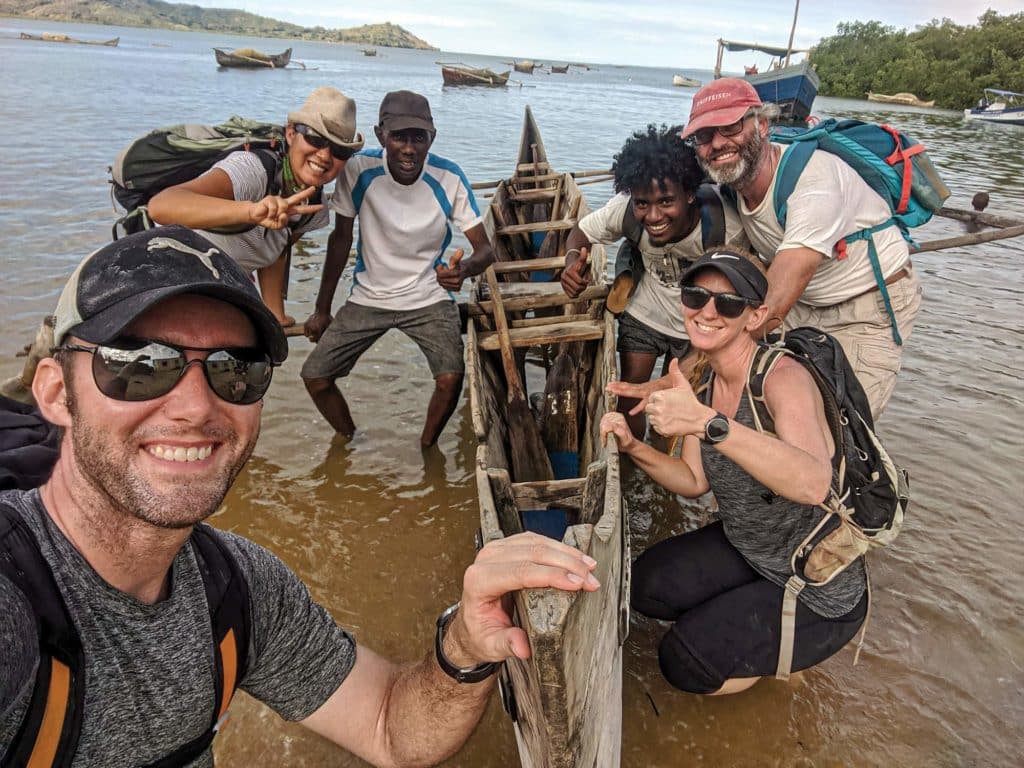
Off to See the Giants
We departed the next morning for our last big stop in Madagascar. We sadly said goodbye to Carlos and Linda, and spent two days sailing to Moramba Bay, a popular cruiser hangout. The river had a narrow entrance that feeds into a big natural harbor, wide enough to fit a dozen boats, but mostly we had it to ourselves.
Throughout the day, several dugout canoes approached us, offering to trade limes and bananas for milk, clothes or medicine. But the draw to Moramba Bay for sailors is access to another famous Malagasy resident: the baobab tree. From our boat we could already see dozens. Following our friends’ directions, we drove our dinghy as close to shore as we could, anchored, and slogged through the calf-high water and mud to the beach, where we followed trails and found ourselves standing among the giants. The baobabs are distinctive, with their wide trunks devoid of branches for hundreds of feet before a cluster of foliage at the top.
We stayed for days, and when we departed Moramba Bay, it was with trepidation of the many trials that lay ahead. South of us, there were few protected anchorages, and then the treacherous Mozambique Channel. And behind us, we were leaving a country so different from our own, but one filled with opportunities we would have never found elsewhere.
Chartering in Madagascar
Chartering in Madagascar is a tiny industry, but exploring Nosy Be on a charter boat can be greatly rewarding. There are a limited number of boats in the charter market, meaning guests can find themselves completely alone if they desire.
The charter companies are based out of the Yacht Club De Nosy Be in Crater Bay. The marina is the only place to plug into electricity and top up water tanks. Provisioning from Crater Bay is best at Leader Price, a 30-minute drive from the marina, though local fruits and vegetables are freshest at the roadside stalls or in Hell-Ville at the market.
The peak time to charter is winter—May through October—when the temperature is cooler and the weather more consistent. The summer is monsoon season, and rainstorms become more frequent while the temperature peaks. Cyclones are active from December to March.
Various itineraries are available, from four to 14 days. Anchoring is easy, and winds are often light, making for comfortable, lazy sailing. The four-day itinerary covers the nearby Mitisio Islands, just north of Nosy Be. Longer itineraries include much of our route sailing south down the coast.
The spectacular wildlife, above and below the water, plus the friendly people and stunning geography will make a charter in Madagascar the memory of a lifetime.
Charter companies operating in Nosy Be include:
Dream Yacht Charters ( dreamyachtcharters.com )
East Africa Yacht Charters ( eastafricayachtcharters.com )
Madavoile ( madavoile.com )
Ulysse Explorer ( ulyssexplorer.com )
Amy Alton and her husband, David, finished their circumnavigation in March 2020. Her stories of adventure and advice are available at outchasingstars.com .
- More: catamarans , Destinations , Fountaine Pajot , Indian Ocean , madagascar , print 2021 june-july
- More Destinations

The Halfway Point: Sailing to Bermuda

Cruising the Northwest Passage

An Oasis in the Middle of the Atlantic

Global Movement of Cruising Boats

TradeWinds Debuts 59-foot TWe6 Smart Electric Yacht

Good Bread for Good Health

Center of Effort

- Digital Edition
- Customer Service
- Privacy Policy
- Email Newsletters
- Cruising World
- Sailing World
- Salt Water Sportsman
- Sport Fishing
- Wakeboarding


The Perfect Travel Itinerary For Madagascar
70 Comments
- Last Updated On: September 10, 2023
Madagascar may be the definition of exotic destinations. Nestled in the south Indian Ocean, this island is home to thousands of endemic animal and plant species found no where else in the world. Its landscapes are as different as they are otherworldly, as well as its people, a curious mix of Southeast Asian and African. Of all my travels around the world , Madagascar is still the answer I give to people when they ask me my favorite country. I spent a month in Madagascar which I think was still a bit too short. I could have easily spent three months because there is so much to see. There’s as much geological diversity here as there is in the United States.
I spent just under a month traveling through Madagascar. It’s not an easy place to travel through . Roads and general infrastructure here is some of the worst in the world. The main highways are equivalent to side streets in most other countries, but riddled with potholes and teeming with people walking their ox-carts.
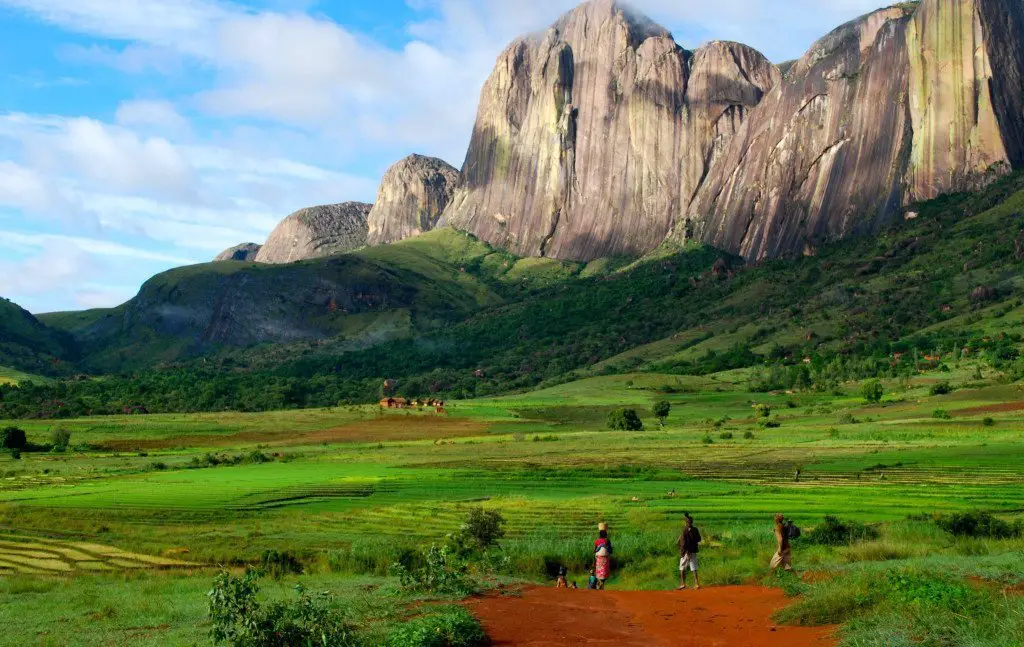
I would recommend a minimum of 10 days in Madagascar (not including the flight to get here which can be very long), purely because the road conditions are awful and the sole airline, Air Madagascar, is suspect at best.
Interested yet? If you’re planning to visit Madagascar, make sure to read my Guide to Traveling Madagascar for all the important things I picked up along the way. Then read the itinerary below 🙂
Where I went
In total, our trip was 28 days and our itinerary included the following
- Antannarivo
- Avenue of the Baobabs
- Tsingy Stone Forest
- Ranomafana National Park
- Isalo National Park
- Andasibe National Park
- Ile Sainte Marie & Ile Aux Nattes
If these sights are on your list and you have about a month for your visit, this post is for you! This itinerary can easily be tailored for a two week or three week Madagascar itinerary. Just pick the places you want to go!
I booked most of my accommodations through Booking.com as it seemed like most of the hotels in the country have adopted use of this platform. In previous years, you’d have to call in advance to book but they’ve caught on since!
In depth Madagascar posts
Like always, this guide is a general overview of the trip I did and to help you plan your wonderful trip to the country. Make sure to read the detailed posts below of all the places I visited for more information, pictures, and videos!
- Guide to Traveling Madagascar
- Morondava and the Avenue of the Baobabs
- Ile Sainte Marie and Ile Aux Nattes
Full Itinerary:
Day 1-5: Straight to the Tsingy Stone Forest
We landed in Antananarivo International Airport in the early afternoon on a South African Airways flight. After clearing immigration, which gives all Western passports FREE 30 day tourist visas, we met our driver, Serge, waiting for us at arrivals. We planned on exchanging some Euros at the FX counters at the airport but our driver said he had a guy that would hook us up with better rates. A bit early in the trip for potentially shady practices, but what the hell?
My driver’s name was Serge, and his email is [email protected]. Feel free to email him and see if he has availability for you!
We met with the guy, and he did indeed give us a better exchange rate and we were rolling in stacks of cash (the biggest bill in Madagascar is worth $3-4). We decided to skip Antananarivo (Tana) and drove straight towards Antsirabe where we spent the night.
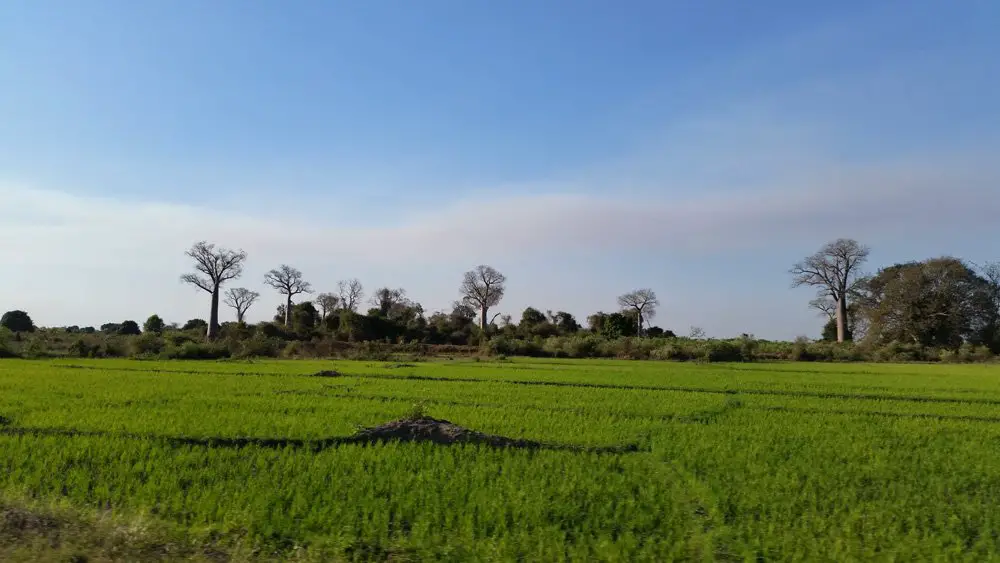
Antsirabe to Tsingy Stone Forest
The next day we headed the Western beach town of Morondava. The drive took the whole day, but not without beautiful rice terraces and otherworldly landscapes. Morondava is a must stop for those visiting the Tsingy Stone Forest because it’s impossible to drive there at night. We would come back to Morondava afterwards for a few nights of R&R.

The next day we drove straight to the Tsingy Stone Forest . It was offloading and make shift barge ferries the entire way up but we made it to our guesthouse just before sunset. We stayed here for three nights and hiked the Grand Tsingy and Petite Tsingy. Unforgettable places!
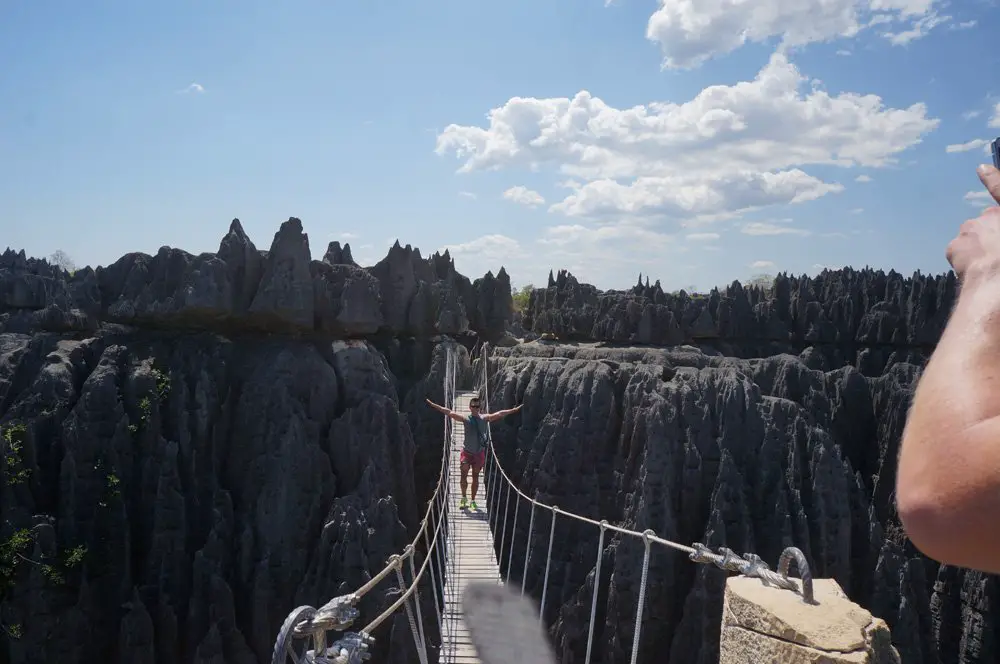
Day 6-8: Morondava and Avenue of the Baobabs
Day 6 was spent entirely on the same road back towards Morondava. We arrived around sunset to one of my favorite places in the world, the Avenue of the Baobabs . This is one of those places that looks amazing in photos, and looks just as magical and special in person. The giant baobab is native only to Madagascar and it’s about as unique of a tree as there is.
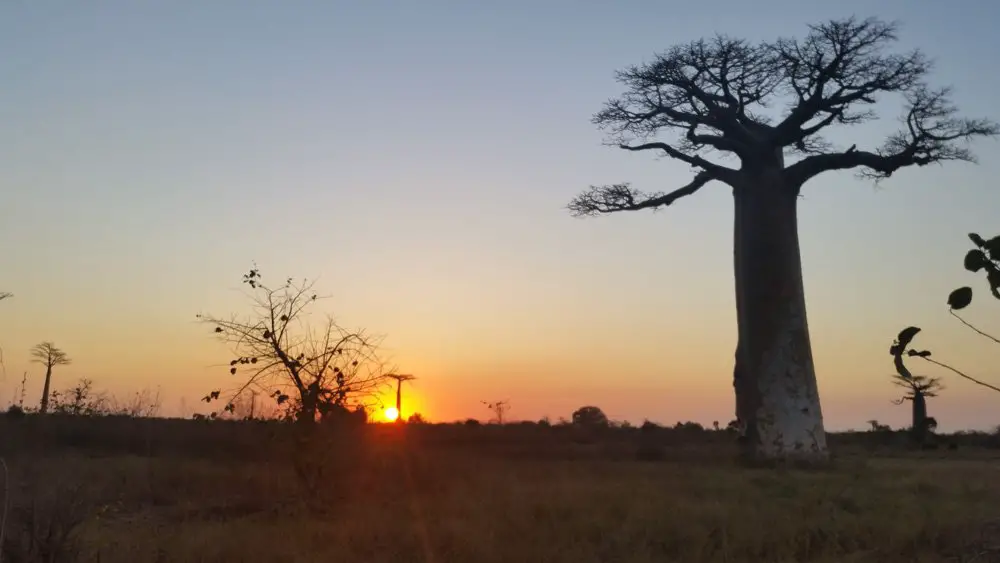
We stayed the next two nights in Morondava. We enjoyed the beach, partied with the locals by drinking copious amounts of Three Horses Beer, and hung out with local fisherman to eat hearty portions of lobsters and prawns.
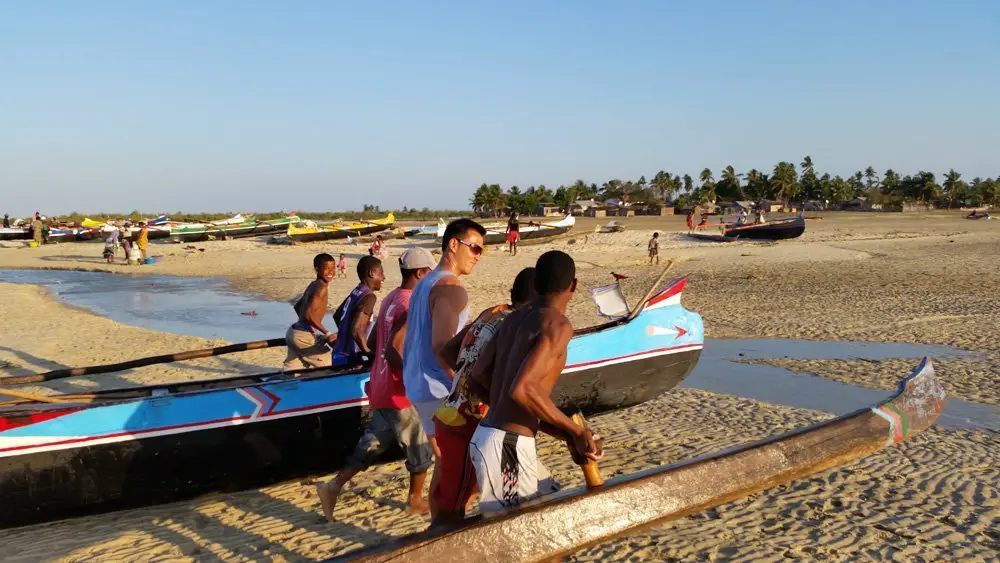
Day 9-11: Ranomafana National Park
Day 9 was another all day drive. We had plenty of these because Madagascar is a surprisingly big country, and the roads are so bad, you’re never driving more than 90 km/h. We arrived in Antsirabe (where we also spent the first night), to spend the night.

The next day, we drove south along the RN7, Madagascar’s main highway, to Ranomafana National Park . This park is known for their numerous species of lemurs, including the elusive golden bamboo lemur. The contrast in scenery is extraordinary as Ranomafana looks like a tropical rainforest, where the previous segment of our trip was some combination of desert and ocean.

We spent two nights in Ranomafana and spent a whole day hiking through the park.
Day 11-14: Isalo National Park
Day 13 was another transit day as we drove along the RN7 from Ranomafana National Park to Isalo National Park. The landscape changed yet again to rugged landscapes that reminded me of the American southwest, but with palm trees dotting the horizon. We made the full day drive and stopped at various locations like the base of the Andringitra Moutnains and the Anja Nature reserve, home to numerous ring tailed lemurs.
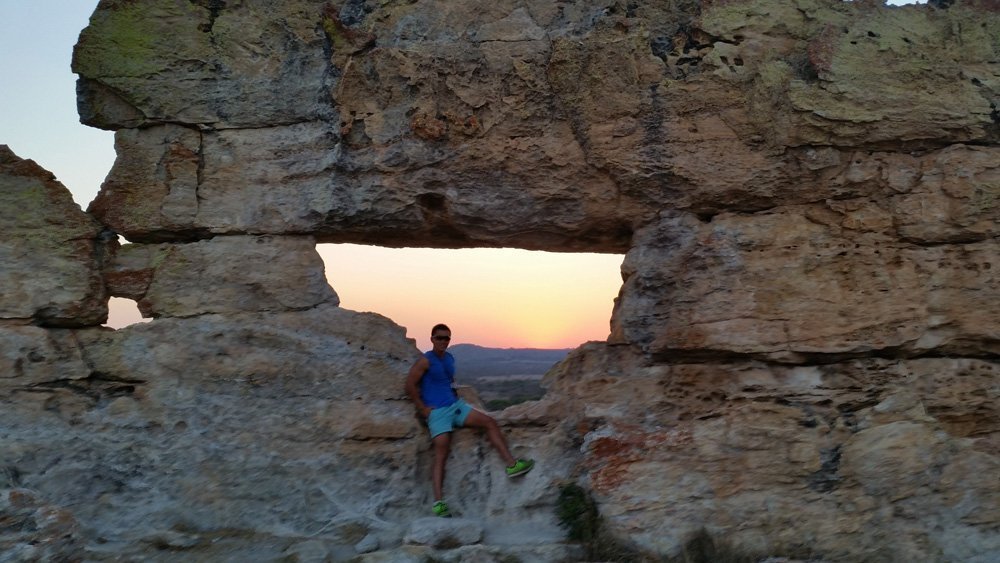
Isalo National Park is one of the most popular parks in the country and this is where we decided to stay in our “luxury” accommodations”. We spent three nights here, and I could have used another day as I very much enjoyed it here.
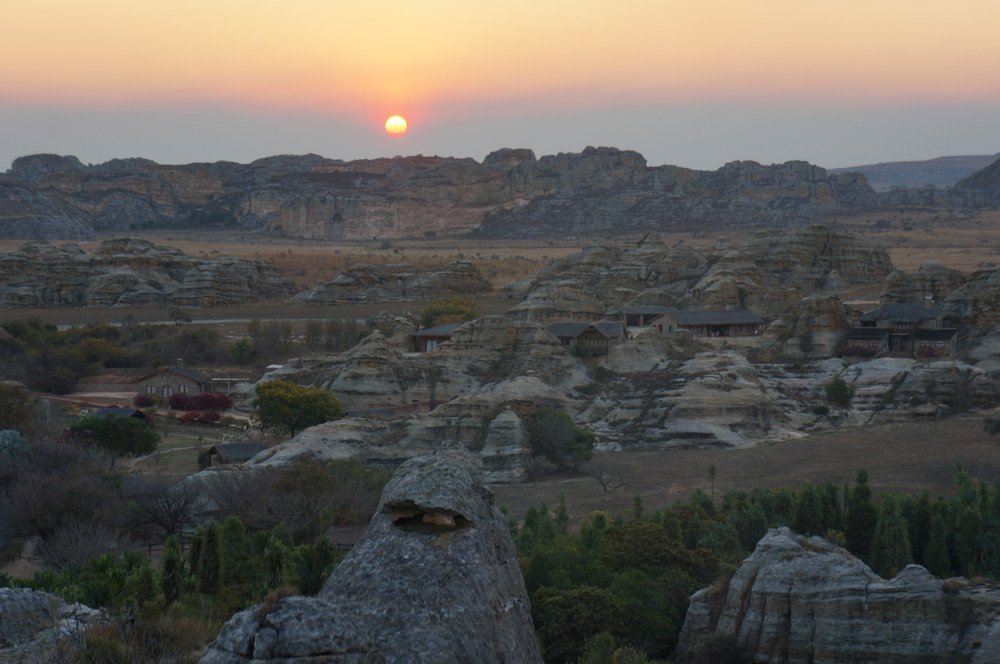
We hiked all around the park, including the two canyons, Windows of Isalo, and Piscine Naturelle. The hiking trails here are long and physically challenging. There are many options so you can choose what best fits you. Some people spend days hiking through the park, camping along the way. While we weren’t that adventurous, we felt like we saw a lot of the park.

Day 15-18: Andasibe National Park
After an amazing visit to the Isalo National Park, our next destination was Andasibe National Park. This is the most visited park in all of Madagascar, likely because of its proximity to the capital (3-4 hours drive). It is home to the Indri lemur, the largest species of lemur that is famous for its loud and distinctive howl.

There are numerous luxury lodges here. One of these, the Vakona lodge, has a sanctuary for orphaned and domesticated lemurs of all species. You can play with them as well as they are completely unafraid of jumping on you. I’m not sure if there is some questionable ethics happening at this place, but it was a great experience nonetheless.
Day 19-25: Mahambo and Ile Sainte Marie
The last leg of our trip was beach time! From Andasibe, we drove to east towards the port town of Mahambo where we stayed for the night. They had a resident ring-tailed lemur that was also domesticated and followed us around the entire time. It even followed us into our bungalow where we tried (unsuccessfully) to kick it out. It ended up staying the night in our bungalow which in hindsight, was pretty cool.
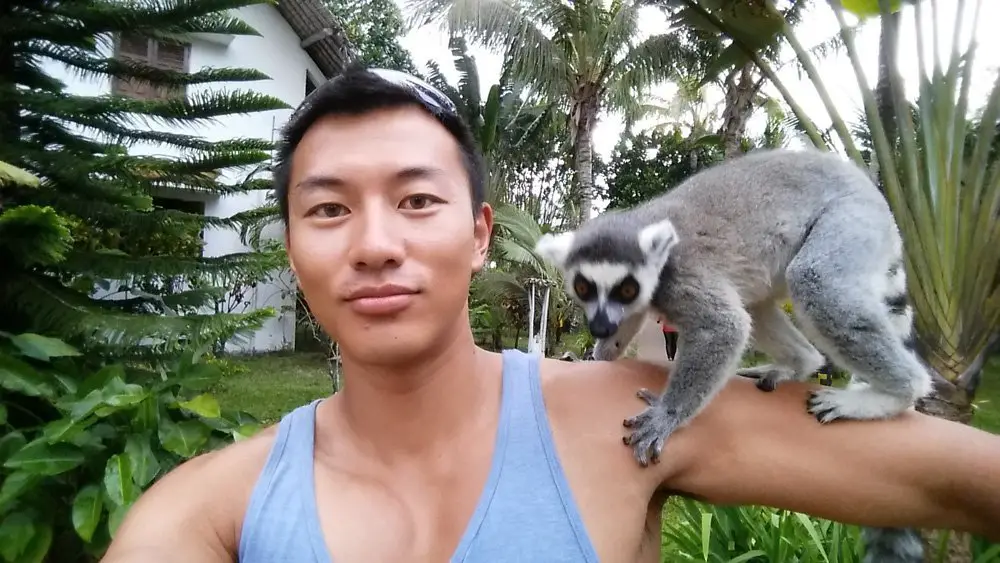
The next day, we drove to Soanierana Ivongo, where we caught the passenger ferry to Ile Sainte Marie . Upon arrival, we took another transport to the smaller nearby island of Ile Aux Nattes. This place was pure paradise. Not only was there the bluest waters and whitest sand, but we had the whole place to ourselves. We did day trips to scuba dive, and took mopeds all around Ile Sainte Marie.
Some of the nicest beaches I’ve ever seen are in Ile Aux Nattes. It is just so rustic here that we felt like this beautiful slice of paradise to ourselves (which we pretty much did). Alternatively, you could pay thousands of dollars to stay at a resort on Turks and Caicos, or go to a much more stunning and incredibly untouched place like Madagascar!

Day 25-27: Antananarivo
Alas, the end of the trip. We took the morning ferry back to Soanierana Ivongo, and took a bus to the port capital of Tamatave. From Tamatave, we charted an entire Taxi-Brousse, the local form of transportation as we didn’t want to wait for it to fill up. We had a day to explore Tana which is about all you need.

Tana offered more to see than I had imagined. There are beautiful viewpoints all around the city as it is in the highlands, as well as nice colonial French architecture.
Day by Day Itinerary
Day 1: Land in Tana, drive to Antsirabe Day 2: Drive to Morondava Day 3: Drive to Tsingy Stone Forest Day 4: Hike Grand Tsingy Day 5: Hike Petite Tsingy Day 6: Drive back to Morondava, stop at the Avenue of the Baobabs Day 7: Relax in Morondava Day 8: Drive to Antsirabe Day 9: Drive to Ranomafana National Park Day 10: Hike Ranomafana Day 11: Ranomafana to Isalo National Park Day 12: Hike Isalo Day 13: Hike Isalo Day 14: Isalo to Andasibe National Park Day 15: Hike Andasibe National Park Day 16: Hike Andasibe National Park Day 17: Andasibe to Mahambo Day 18: Mahambo to Ile Sainte Marie Day 19: Ile Sainte Marie / Ile Aux Nattes Day 20: Ile Sainte Marie / Ile Aux Nattes Day 21: Ile Sainte Marie / Ile Aux Nattes Day 22: Ile Sainte Marie / Ile Aux Nattes Day 23: Ile Sainte Marie / Ile Aux Nattes Day 24: Ile Sainte Marie to Antananarivo Day 25: Antananrivo Day 26: Fly out
This itinerary hopefully will help you in planning a trip to Madagascar. To be honest, I could have stayed at least another week or two. There is just so much to see and so much geological diversity that you could spend months traveling the country. If you have any questions or comments, please leave below!
Continue Reading:
- Guide To Visiting Andasibe National Park And Lemur Island, Madagascar
- The Ultimate Guide to Traveling Madagascar, The Red Island
- Guide To Visiting Ranomafana National Park, Madagascar
- The Ultimate Guide to Ile Sainte Marie and Ile Aux Nattes
- Ultimate Guide To Visiting Isalo National Park, Madagascar
- Guide to Visiting Morondava and Avenue Of The Baobabs
- Guide To Hiking The Tsingy Stone Forest, Madagascar
- The Best Of Johnny Africa – Top Moments Traveling Through Africa
- The Ultimate One Week and Two Week Travel Itinerary for Uganda
- The Perfect Las Vegas To Zion National Park Itinerary
- The Perfect South Africa Honeymoon Itinerary And Guide
- The Perfect One Week, Two Week, and Three Week Travel Itinerary For South Africa
- The Perfect 5-Day Itinerary For Zion, Bryce Canyon, Grand Canyon, and Antelope Canyon
- The Perfect One Week And Two Weeks Travel Itinerary For Albania
Related Posts

The Perfect Sri Lanka Travel Itinerary: One Week, 10 days, and Two Weeks
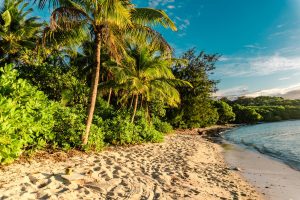
The Perfect Fiji Honeymoon Itinerary: One To Two Weeks

The Perfect Fiji Travel Itinerary: Beaches, Diving, and Island Paradise

The Perfect Vietnam Travel Itinerary: One Week, Two Weeks, and Three Weeks
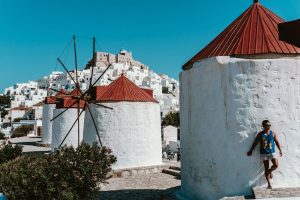
The Perfect Two Week Travel Itinerary For Greece

The Perfect One Week Itinerary For Greece
Leave a reply cancel reply.
Your email address will not be published. Required fields are marked *
Yes, add me to your mailing list
Add Comment *
Save my name, email, and website in this browser for the next time I comment.
Notify me of followup comments via e-mail. You can also subscribe without commenting.
Post Comment
Magnificent goods from you, man. I have keep in mind your stuff previous to and you are simply too wonderful. I really like what you’ve acquired here, certainly like what you’re stating and the way in which in which you assert it. You make it enjoyable and you continue to care for to stay it wise. I cant wait to learn far more from you. This is really a wonderful site.
How long did it take you from TSINGY STONE FOREST to Morondava? Is the only way back to the capital or is there a shortcut maybe?
Hi it is a full days drive from morondava to the tsingy. The roads are quite terrible and you’ll need to Take it slow. No other way around unfortunately!
Hi Johnny, I have 5 days 4 nights to spend in Madagascar, where I will arrive in December by flight at Antananarivo in the morning at 10.40 and leave at 14.45 on the fifth day. I wonder if it is possible to visit and see my 3 main objectives: Boabab trees in Boabab Avenue, the lemurs and Tsingi rock forest? Thanks 🙂
Hi arifin, I think it can be done but may feel very rushed and you won’t see as much. You can fly to morondava as soon as you land, and stay the night there while visiting the baobabs at sunset. The following day you will drive the whole day to the tsingy (and see the baobabs again as you must pass through them to get to Tsingy). The 3rd day you can make a hike through the big tsingy, the 4th day you would then drive back to morondava, and the 5th day you can fly to tana in the morning.
Hi My husband and I are traveling to Madagascar next month for 2.5 weeks. Can you pls suggest what shall we prioritise to visit in such a short time. We would like to spend a few days on the beach to relax Thank you, Monika
hi Monika, i would visit the western part of Madagascar per my itinerary, and then maybe a few days in Andasibe and then off the beach. But that is jus tmy preference. You can see my other post and pick what most makes you excited!
Thanks for putting together a great blog post about madagascar. It is really helpful to see an itinerary to see what is possible to do in madagascar. It looks like you had an amazing trip. I am going to madgascar for two weeks in August and I am trying to figure out one last piece of my itinerary. I see you travelled in one day from Isalo National Park to Andasibe. How long did this take you? We want to fit a visit into Isalo National park and it would be great to have an extra day by being able to drive from Isalo National Park to antananarivo in a single day.
Hey Chris! We actually stopped in Ambositra for the night. I don’t thjink it’s possible to drive from Isalo to Andasibe in a day. Alternativelly you could probably reach Tana in one day from Isalo as well!
Hi Johnny, I will go in Madagascar from 05 September to 21 September. We are a couple, and we are sportive and very very adaptable. Can you suggest an itinerary? (I would spend one day to play windsurf if it’s possible 🙂 )
tks best regards
Thanks for an amazing overview.
We plan on going to Madagascar this summer for 4 weeks. Here we have used your itinerary as the main inspiration. This include: – Nosy be (1-3) – Diego Suarez (4-6) – Morondova and Tsingy (7-13) – Isalo (14-16) – Ranomafana (17-18) – Andasibe (19-20) – Ile Nattes (21-26) – Tana (27-28)
However, when reading your itinerary one thing would be nice to know for all of it to add up. How did you get from Isola to Andasibe and how long did it take? 🙂
Thanks again! Marc
Hey Marc, that sounds like a great trip! One thing to note, from the tsingy and morondava to isalo will take you 2 days of driving so you’ll want to account for that. we took a driver with a car throughout our Madagascar trip. Hope that helps!
Hi Johnny, Thank you for your insights on madagscar, they have been helpfil. I have just started to plan a trip to Madagscar, from the 21st june to the 15th – my plane arrives at 21st June 22:00 pm and leaves at 15th 00:30 am.
I would like to visit more or less the places you did, but I think I might be short on time. I would like to visit Tana – Andasibe-Mantadia Parl – Ranomafama park – Isalo Park – Tsingy Baobas – St marie Island/Ille aux Nattes and possibly Kirindy. I wanted to end my trip with 5 nights in St Marie to relax and do some whale watching.
Do you think I could fit all this in such a shhort timeframe? What would you recommend?
Hi thank you so much for your blog post it was really informative and made it all sounds so exciting. I am going to Madagascar from March to April and will be staying in Andasibe, with food provided by a family. It is my first time travelling abroad by myself and was wondering whether you had any general tips; e.g. what things to avoid, what foods to steer away from and whether anything is an absolute must to bring etc… any tips will be super helpful. Thank you so much
Hi Poppy, that is quite the first place to travel alone to!! No matter, you will absolutely love it! I would say that the local food in madagascar can be quite tasty but if you’ve not traveled to very undevelope dplaces before, i would take it easy on the food until you know you can handle it. I hope you planned some trips afterwards however because Madagascar is such an amazing country that you’ll want to see more than just the Andasibe area!
I don\’t have a website so not sure how to respond to your blog posts. Sorry. But, I love the blog on Madagascar. I am planning a trip in May to see my niece in the peace corp. I’m nervous because she wants to plan it all, but I want us to use tour company such as GMT +3 TOURS. I keep hearing about the “malagasy stomach” and have been advised to be careful of what we eat. What would you recommend for food? Stick to hotels? They say “if you can’t peel it, don’t eat it”.
We are only there 10 days and she has us covering a lot of ground: Tana – Andasibe – Tamatave – Mahambo – St. Marie, then a boat to Ill Au Natte for 2 nights, then a regional flight to Tana to head back to US. Sounds aggressive. Your thoughts?
Hi Kim! Thanks for the kind words. I think like most places, you watch what you eat depending on your travel and stomach threshhold. What may rough up one’s stomach won’t for others. But generally, I avoid “salads” and fruits without an outer layer. I think if your niece is in the peace corp, she’ll have a good understanding of the country and know someone that can help her book her accoms. For the most part, you will be staying at modest hotels and guesthouses where the food will be good quality.
As for your itinerary, I think it should be enough time although I’d spend less time in Tamatave/Mahambo and more time on Ile Aux Nattes. Something like 2 days Tana, 3 days Andasibe, 1 day Mahambo, and 4 days in Ile Aux Nattes. Enjoy!
Hi Jonny, Thank you for your info. This is really helpful! We are planning a trip to Madagascar and are curious when the best time to go is. Do you have any advice?
Much Gratitude Aimee
Hi Aimee! I’d always recommend to travel in the dry season in Madagascar. This is May to November for the best times. The wet season can be very beautiful too of course but the weather is just very variable and some sights are out of reach like the Tsingy. Make sure to read my Madagascar Travel Guide for more info!
I’m looking to go with my 8 year old who is obsessed with the animals and nature in Madagascar. Did you see a lot of animals? That is his main goal, so trying to make sure we fit in plenty of forest/jungle time. He wants to see everything from giraffe bugs to lemurs.
Hi Karilyn, I defintely saw many many animals as you can see in all my detailed posts of the country. Lemurs were of course a daily sighting and other native animals as well. It was a great experience and would definitely recommend it, even with your 8 year old!
Hello Johnny, great itinerary! My friend and I are planning to go to Madagascar for 3 weeks-1 month, but the problem is, none of us drive. Will it be a problem? will public transport be a problem there?
Thank you:D
Hi Chandra, I would hire a car with a driver . This is the standard way to travel around Madagascar. Between 2 people, the cost will be very reasonable imo and you can see so much more in that time vs taking public transport.
Hey Johnny,
We are group of 3 planning to travel in Madagascar from 3 – 18 Nov. Reading your blog post, we understand that having a driver is a necessity. Just would like to ask you if you might have some contacts on EN speaking drivers and would be willing to share? Thanks a lot. Zuzana
Hi Zuzana, definitelyi would recommend a driver for your trip!
I would email my friend Serge who drove us around. He spoke decent English but as with everyone in Mada, English is their 3rd language so it was hard to find people that spoke very good English.
Hey Johnny, great post! I’m spending 8 nights in Madagascar in November and really want to see ISM, but was also hoping to see some Baobabs. Is that a reasonable goal for such a short stay? Or do you recommend choosing one direction or the other? I’m assuming the Baobabs are only in Morondava . . . is that true?
Hey Evan, I think with 8 nights you could squeeze that in. If you’re not going to tsingy, then it is just in and out of morondava to see the baobabs. You could either fly to morondava from tana, stay the night while visiting the baobabs, or take 3 days by driving (one day to Morondava, one day baobabs, one day back). From tana, fly to ile sainte marie and relax for 4 nights.
You won’t get to see any of the national parks or lemurs this way but it will check off those two things in your post. Hope that helps!
Ok, cool! That’s helpful. Thanks for the ideas.
Hi Johnny, I am currently considering a 2 month trip to Madagascar with a group of friends as part of a work placement. This would mean that we would be busy during the weekdays and able to travel on the weekends to see the rest of the country. I have read on your article here and on other websites that travel between sites can take up to a full days worth of travelling at some points. I was wondering if it would be possible to travel between say, Antananarivo and Ile Sainte Marie (or Tsingy stone forest or avenue of the baobabs, etc.) and back within a weekend (friday afternoon-saturday) whilst still being able to spend time at these sites and fully appreciate them. Or if we would need to dedicate more time to each venture out. Cheers
Hi Dan, unless the roads have significantly been improved in the last few years (which I can’t imagine is the case), it’s impossible to see the Tsingy within a weekend. You’d need to fly to Morondava, and then it takes a full day just to reach Tsingy on backroads and “ferries”. Ile Sainte Marie I think is posisble. You could fly from Tana to ISM and relax for a day or so but I think that is a bit much for a short weekend. I think the most feasible if you are only doing weekend trips are to the Andasibe and to fly to Morondava . Otherwise, would just save all the godo stuff for when you’re done with your work placement and have some proper time to explore!
Hi Johnny! Your itinerary has inspired us even if we have only 12 days so we need to speed up! We would like to ask you how much was to take a taxi brousse all for yourself?
Thanks Giovanni! I only took the Taxi Brousse from Toamasina to Tana. If I were to have used a taxi brousse for my entire trip, it would take me twice as long to complete this itinerary! However, you will save an incredible amount of money if you’re okay roughing it as a taxi brousse from Tana to Tulear for example is only 40000-50000 ariary. I would definitely not recommend taxi brousses if you only have 12 days!
Can you give me some ideas on costs for renting an ENTIRE taxi-brousse from Point A to B (say Andasibe to Il St Marie island area) and are the drivers reluctant to do this? Does it make the locals angry? I want to get a car and driver to do most of the trip, but then ditch him once we get to Andasibes since we will be there for 3 nights. I am wondering if we should hire another car and driver from Andasibe to take us to the islands or what…. Or maybe our guest house will have options for us? Ugh. Thank you for this blog. Still, Madagascar is a tough nut to crack at first with the planning! But thanks for helping!!!
Hi Emily, there is no taxi brousse to Ile Sainte Marie as it is an island. You’ll need to get to Toamasina where there is a shuttle to the ferry station in Soanierana-Ivongo. From Andasiba, you should be able to get a pickup with the Cotisse bus company that goes from Tana to Toamasina and stops in Andasibe to pick up tourists. I would talk to your guesthouse/hotel in Andasibe to see if they can arrange it for you. Should be pretty straight simple!
Hi Johnny thanks for this itinerary. I am going with a friend in Madagascar too in October, we stay 2 weeks, and we plan to follow more or less your itinerary. I have a few questions though: as far as I understand, you rented the car with the driver until Ile Sainte Marie and then you arranged the trip back to Tana yourself? About the driver, as we also plan to contact GMT+3, is the food and accommodation included in the price? When it comes to Morondava instead, is there anything special to see there or you used it as a starting point for the Tsingy National Park? Thanks a lot!
Hi again, morondava had a really nice beach which was seemingly devoid of tourists. Morondava js also where the baobabs are which are kf course amazing. You will see the avenue of the baobabs twice if you go to the tsingy since you have to pass through it to get to the Tsingy. Enjoy!
Thank you! 🙂 another question, How did you go from Soanierana Ivongo back to Tana? Does the taxi brousse take one day or it stops overnight somewhere else? How did you arrange it? Giuseppe
Hi again! So with the ferry from Ile Sainte Marie to Soanierana Ivongo, it includes a taxi brousse style transfer to Toamasina. From Toamasina, you can either take taxi brousse to Tana, or they now have the Cotisse shuttles which are a much more luxurious and comfortable van style transport. It is more expensive obviously, but worth it imo.
Thanks Johnny for the answer! So for what I understand it seems like you took a normal taxi brousse and not a cotisse? After you arrive to Toamasina, is it easy to find a taxi brousse (or Cotisse, whatever) that take us to Tana on the same day without driving overnight? Because you made it, but I read about many people who slept in Toamasina and then took a taxi brousse the next day. Last, could you please tell us what company for ferry/transport to Toamasina you took? Thanks 🙂
Hi Again, yes plenty of people sleep in Toamasina before taking the bus the next day. We had a flight the next day so this wasn’t an option. So from where we were dropped off as part of the ferry shuttle, across the street was a taxi brousse station where I negotiated renting out the entire van to take my friend and I back to Tana. This was like 250k MGA at the time but this was before they had the cotisse. Nowadays, I would just reserve a cotisse beforehand and they run multiple times a day between the two cities. As for ferry companies, you can read about all that on my Ile Sainte Marie post !
Dear Johnny, thanks for this itinerary! I am going to Madagascar in October with a friend and planning to rent a car with driver. I also bumped into GMT+3 online and I just now realized that you also booked through them. My question is, the price you paid (40eur/day) includes also accommodations and food for the driver? Only the gas isn’t included? Also, as far as I understood you had your driver until Ile Sainte Marie? Then from Ile Sainte Marie back to Tana you arranged it yourself with public transports? We’re actually planning to follow your same itinerary, just a bit shorter as we stay only two weeks. Thanks for your help!
Hi Giuseppe, I can pretty much answer yes to all your questions! Nowadays, they have the cotisse bus which is a more high end bus service from Tana to Toamasina so you can arrange that eawsily on the way back from ISM. Enjoy hte trip!
Hi Johnny, Great reading through all your stuff on here. Me and a couple of mates are heading to Madagascar for 1 month also in September. Out of interest is there anything on your trip you felt you missed out on speaking to other travelers and locals, anything you would skip if you had to do it again? Let me know cheers matey!
Hey Tristan, that’s a tough question! I thought my itinerary was pretty solid all throughout. obviously if I had more time I would add things to the itinerary like a visit to the very north (Diego Suarez). If I had like 4 or 5 more days, I would probably do the drive from Morondava to Tulear along the coast. Then make my way up the RN7 back to Tana stopping at the national parks. My driver said the drive along the western coast is very beautiful but the roads are very bad and takes a lot of time. Also, I would consider doing the hike up the Andrigintra mountains if I had few more days (instead of just passing it by).
If I HAD to skip something, I would probably skip Ranomafana National Park as I’ve seen cooler rainforests and I think Andasibe was enough for me to get the gist of it. Hope that helps!
Great write up and this is very helpful! I am trying to decide between Ile Sainte Marie and Nosy Be as a beach destination after doing the main RN7. Do you have any opinions for or against either option? THanks!
Hi Anthony! I never visited Nosy Be so can’t speak to it exactly. I chose Ile Sainte Marie mainly because it was a cheaper destination and had more of a rustic, chiled out vibe. Nosy Be is more for the resorts. You can’t go wrong as far as natural beauty in either place so it just depends on the vibe you’re seeking. Also from what i hear, the diving in Nosy Be is better, which I wouldn’t be surprised of as the diving i Did around ISM was not that great.
Hello Johnny,
Your travel journeys are so amazing. I came across your blog while trying to decided between Mozambique and Madagascar for a short five day break next month.
I think I am leaning more towards Madagascar.
Having read your blog on Madagascar I can see that five days is not sufficient but I was wondering if you could suggest which place (favorite) I should go to in the short time frame I have.
Secondly, is Madagascar an affordable destination.
I would appreciate your feedback
Hi there! Yes Madagascar is a very affordable destination. It is probably one of the cheapest countries you can visit. With 5 days, you rea`lly won’t have much time to explore the island. I would dio either of the following:
1. Fly to Morondava and do a 3 day 2 night tour of the Tsingy Stone Forest and stop by the Baobabs on the way back. 2. Visit Andasibe National Park which is nearby to Antananarivo
You can’t go wrong with either option!
Thanks for the great post. I will be traveling to Madagascar this August. I am staying for a few months, but my mother and grandmother are coming with me, and they will only be staying for a week (which I am now thinking isn’t an adequate amount of time). I think renting a driver will be the best way to get the most out of our time and I also like the suggestion about visiting the western region since our time is limited.
I am curious about the transportation system. You had Serge for 3 weeks of the trip. Would he just get his own accommodations for the nights or did you cover the cost of the accommodations for him?
Hi Gaby! It’s funny, I asked myself the same question about that. “Where does the driver stay?? Does he sleep in the car??”. Turns out the answer is definitely no. He will stay in very modest hotels for locals and sometimes the places you stay in will accommodate the driver as well. It is all included in the per day price they quote you.
In 2014, Serge said he normally pays 10000-15000 Ariary per night at these hotels. Local restaurants have food for 3000-5000 Ariary so he will be sorted. Have fun on your trip!
How much did you pay when using Serge? Is he affordable? Trying to get the best price!
Hi Amy! I paid gmt+3 €40/day for serge. They are a travel agency in Madagascar and contract out their drivers so I don’t know how much serge actually gets from that price. This was 3 years ago so keep that in mind it’s probably more now.
Also gas isn’t included in the price but that is standard through the country.
Thanks for your reply! He is charging a little more, which I expect that is normal. What is the best itinerary you recommend for someone going for 1 week? Also, how much cash should one bring for 1 week? Thanks!
You could do a 1 week trip to the west which you can see the Baobabs and Tsingy National Park. This was my favorite part of the country. Unfortunately, one week isn’t much time since getting around is so tough. Alternatively, you could do Andasibe for a few nights, and then fly to Ile Sainte Marie for a few nights of beach if you’re into that. Almost all places in Madagascar don’t accept credit card, and I’d imagine that hasn’t changed in the last few years. I think a thousand euros per person should be good. Note that there are ATMs all over the island.
Johnny, thank you so much for all your replies! They are super helpful. A few more questions-
– Do you have a page that talks about Andasibe? I asked about Tsingy and unfortunately, the roads are bad due to a cyclone that happened this year so we are unable to visit it 🙁
– Did you fly in Madagascar? How were the flights? Reliable?
– Would you recommend Serge? What was your experience with him like? How did you communicate with him besides email when getting there? Also, how much should one tip a private driver?
Thanks again!
Ah bummer! Yes It is rainy season right now and roads don’t usually clear up until May or June. I didn’t fly in Madagascar and there is just Air Mada that does the domestic flights. It’s not the best from what I’ve heard (could be different now). Serge was great. He has been literally everywhere in teh country and knows everything. He didn’t speak much English when I had him 3 years ago but I can speak enoguh French to converse with him. I think we tipped him about 200k Ariary between two people for 3 weeks of driving.
Also, be sure to read the Guide to Madagascar post I made, will probably be very helpful for you!
Did you pay in advance (full amount) with the company gmt*3 or did you pay them in person?
I paid Serge upfront. I don’t think GMT+3 had credit card processing systems when i went but perhaps they have that functionality now. Would be comfortable with either option actually.
Hey Johnny! I just found your site and it seems really helpful. I’m going to southern Africa for 6 weeks before heading up to Kilimanjaro this August/September. I’m starting in South Africa, but I’m interested in going to Madagascar for a little while. I’m primarily interested in Tsingy and the Northern Coast (which I saw wasn’t on your itinerary). I’m travelling alone and slightly intimidated by the difficulties of traveling in Madagascar. How did you set up your driver ahead of time? Do you think it’s safe for a solo female to travel this way in Madagascar? Any tips are greatly appreciated!!
Hi Emily, super jealous of your upcoming trip! I didn’t go to the north coast but my driver always raved about how the beaches in Diego Suarez were his favorite. I got my driver beforehand by emailing some tour operators. You can read about it Here .
Also, I think being a solo female is no problem either. I saw a bunch of solo female travelers along the way. I wouldn’t recommend trying to get around with the taxi brousse system. You need a lot more time and patience for that!
Thanks so much for your response! I’ll send an email to the GMT+3 and see what I can get set up!
Awesome. Enjoy your trip!!
Hi Jonny, This has been so helpful. I am desperate to get to Madagascar but unfortunately I have only 2 weeks there. I really would like to dive, I have never done it before so wandered if there was a place to learn at Ile Sainte Marie as this is the place I have been more geared towards. Saying that I am trying very much so to do this trip on a budget! Any recommendations? Also did you travel and find places to stay along the way or did you book in advance to stay? Any help would be hugely appreciated seen as a few travel agents seem to have very limited knowledge of the country Cheers
Hi Louise, there are definitely places to learn how to dive. I did my diving at Princess Bora resort and they were fantastic. You can read all about it on my Ile Sainte Marie Post. There are also plenty of cheap accommodations and where I stayed on Ile Aux Nattes was simply paradise.
As for booking everyhting in advance, you definitely don’t need to do it but since you’re only going for 2 weeks, I would recommend it as it’ll give you more time to enjoy things!
Dear Johnny, how was the weather in Ile Sainte Maire in september? I am planning to go there in the end of august -.september.
Hi Filip, I went during the end of September and the weather was as you’d expect from a tropical destination during the dry season. Mostly sunny, but sometimes there would be a short storm, and there was one day where it was mostly cloudy. August/Sep is firmly int he dry season so I don’t think you need to worry about any prolonged periods of storms (that’s more Dec-Mar)!
Thank you for your reply. Mostly, I am interested in temperatures. I have read that the temperatures that time in Ile Sainte Maire in the end of August – early september are around 24.
Ah OK, ya the temperatures are most certainly warmer than 24. Maybe that is in the middle of the night but I can assure the temperature is well into the 30s for the day. And it’s humid, so add few more degrees for real feel temperatures!
I’ve wanted to visit Madagaskar since I wantched the movie. I hope I’ll get a chance soon. Thank you for sharing this useful post.
Yes and you definitely should! It’s a wonderful country and you will see plenty of King Julien’s around 🙂

+1 615 648 1972
Customer support
Website open 24/7
The team at Amazing Travel Madagascar welcomes you. We are proud to be at your service and we look forward to planning your trip to Madagascar. Zo R. - Co-founder

Tours with Amazing Travel Madagascar are immersive trips to explore the beauty of our country and to discover the culture of Malagasy people. By letting us taking care of your journey, you will get a luxury treatment unavailable to independent travelers:
- you will enjoy local attractions with VIP passes;
- you will stay only in the best hotels;
- you will have access to VIP transportation such as a private jet or a helicopter;
- you will get to discover various sites unknown to the general public.
Whether you are traveling alone, with a partner, or with your family, we will personalize your vacation and create the perfect trip package to let you have an experience that you will not forget anytime soon.
Thank you for choosing Amazing Travel Madagascar!
Our Commitment
At Amazing Travel Madagascar, we are passionate about making your dream trip come true. That means we do everything to make your journey with us exceptional and unforgettable.
A VIP experience
We commit to luxury and excellence. Our services include relaxing at luxury hotels, traveling on private jets, sailing on luxury boats, etc.
A tailor-made trip
Valued for our expertise, we create your trip around your tastes. Whether you want to explore the wildlife in Madagascar, or relax at the beach, we organize your journey to the tiniest detail.
A team of experts
Our team is known for their knowledge. Your trip is planned by experienced travel specialists. We work with expert guides, and partner with the best hotels.

Exclusive Trips
At Amazing Travel Madagascar, we created four exclusive tours to give you a glimpse of unforgettable trips. But we’d like to hear more about your ideas and create a bespoke dream trip that meets your needs.
The Southern Charm
The luxury retreat, the northern paradise, the hidden gems.
Lot II M 48 Antsakaviro Antananarivo 101 Madagascar
Copyright © 2019 Amazing Travel Madagascar, SARL. All rights reserved.
- AU: 1-800-665-977
- UK: 0-808-189-1339
- Global: 86-29-8526-9897
- Destinations
- Middle East
- South America
- Central America
- North America
- Tailor My Trip
Classic RN7 Route Tour
Mdg01: 14 days antananarivo - andasibe - antsirabe - ranomafana - ranohira - ifaty - antananarivo.
Tour Type: Private Tour, flexible and customizable Guide & Driver: Experienced English-speaking driver guide & air-conditioned car Hotel: Well selected hotels, open to your own choice
- 1 A driver guide and local expert guides get you covered for an eye-opening tour.
- 2 Approach Madagascar’s iconic lemurs and rare species of reptiles and birds.
- 3 Wonder at ancient baobabs and unearthly octopus trees unique to Madagascar.
- 4 Visit historic sites of the world’s biggest sapphire deposit and the King’s Palace.
2024 & 2025 Special: 10% off - Book before Apr 30, 2024
- Pick-up and drop-off service at airport.
- Economy class airfare of Toliara - Antananarivo.
- Accommodation with daily breakfast at selected hotels.
- Transfers in private A/C vehicle with experienced driver.
- English speaking driver-guide for 2-3 persons.
- Driver and English-speaking guide for 4-5 persons or more.
- Taxes, VAT, and the service fees.
- International flight into and out of Madagascar.
- Meals other than those mentioned in the itinerary.
- Personal expenses (travel insurance, laundry, drinks, etc.).
- Tips for guides and drivers.
- Madagascar Visa Fee.
- One-to-one Customer Service
- 100% Tailor Made by Insiders
- Expert Local Guides
- Hand-picked Hotels
- No Hidden Charge
- Your Money Fully Protected
- About Agate
- In the Media
- Affiliate Program
- Customer Service
- Loyalty & Referral
- Terms & Conditions

Copyright © 1997-2024 All rights reserved
- Cast & crew
- User reviews
Back to Black

The life and music of Amy Winehouse, through the journey of adolescence to adulthood and the creation of one of the best-selling albums of our time. The life and music of Amy Winehouse, through the journey of adolescence to adulthood and the creation of one of the best-selling albums of our time. The life and music of Amy Winehouse, through the journey of adolescence to adulthood and the creation of one of the best-selling albums of our time.
- Sam Taylor-Johnson
- Matt Greenhalgh
- Marisa Abela
- Eddie Marsan
- Jack O'Connell
- 39 User reviews
- 51 Critic reviews
- 50 Metascore

- Amy Winehouse

- Mitch Winehouse

- Blake Fielder-Civil

- Cynthia Winehouse

- Joey the dealer

- Janis Winehouse

- Nick Shymansky

- Raye Cosbert

- Artist Development Man

- Chris Taylor

- Perfume Paul

- Aunt Melody

- Uncle Harold
- All cast & crew
- Production, box office & more at IMDbPro
More like this

Did you know
- Trivia Marisa Abela did all the singing in this film herself. She trained extensively to mimic Amy Winehouse 's vocals.
Technical specs
- Runtime 2 hours 2 minutes
Related news
Contribute to this page.

- See more gaps
- Learn more about contributing
More to explore

Recently viewed

At the office

Michael Horn
Founder and director.

Patrick Ramanampamonjy
Tourmanager and tariffs.

Ony Rakotolalao
Correspondance and quotes.

Fanja Rasolohery

Laingo Iherinjara Raharinosy

Aimé Randriamiharitahiry

Finaritra Rafehivola

Christian Andretseheno

Manitraniaina Randriamanalina

Lovahanitra Andrianjakamanana

Ravaka Erica Andrianjafinarivo
Some of our drivers.
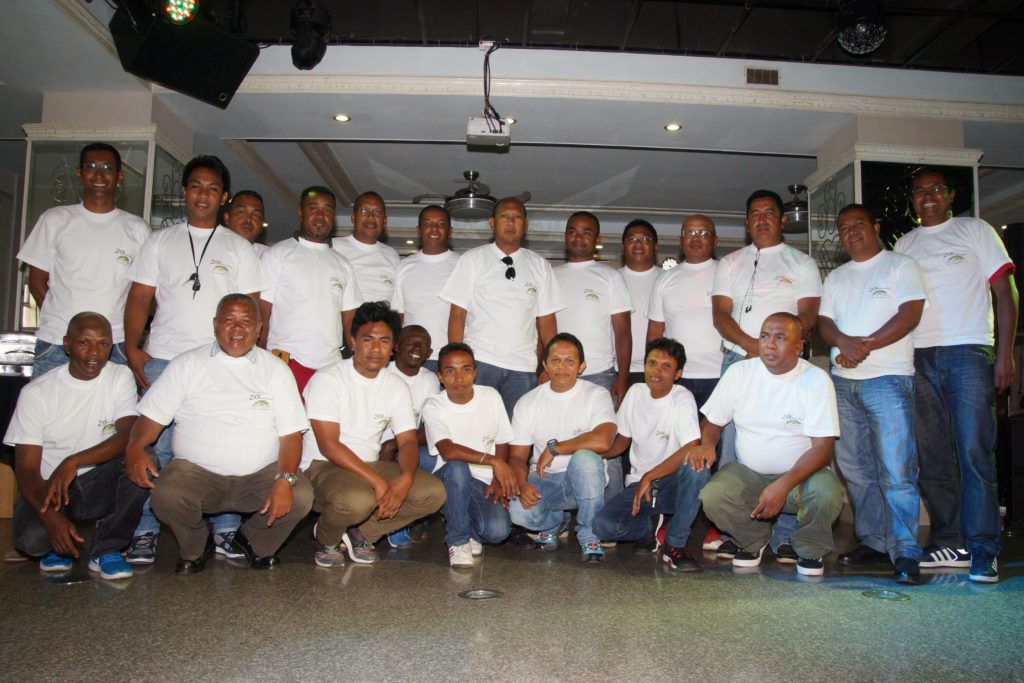
Beyond Pizza and Yale: What to See, Eat and Do in New Haven
Though the academic scene continues to imbue this coastal Connecticut city with a certain gravitas, surrounding neighborhoods are showing off their own cultural capital in the realms of art, food, music and more.

By Amy Thomas
Amy Thomas is a Connecticut-based writer who has loved New Haven since visiting it as a teen in the 1990s.
The 75-foot-long brontosaurus at the newly reopened Yale Peabody Museum in New Haven, Conn., is the same dinosaur that the natural history museum has had on display since 1931. Yet it looks different. A fresh pose. New front ribs. The head is repositioned at a more inquisitive angle. The museum’s four-year renovation not only refreshed the nearly 100-year-old building, but also included an overhaul of the fossil mounts that research has proved to be inaccurate.
The Peabody’s update — 15,000 square feet were added, creating more spacious galleries and dynamic displays — was a long time coming. Like other Yale museums, it is now free, offers more Spanish-language programming, and is inviting more voices into the conversation, with some exhibits being interpreted by students and artists, opening the lens on how visitors might respond to what they’re seeing.
“We want to give the signal that there’s not just one way to react to and interpret what you’re seeing,” said the museum’s director, David Skelly.
The concept of change that threads through the Peabody’s 19 galleries is symbolic of what’s happening elsewhere in the city. Over the centuries, New Haven has had chapters devoted to maritime trade, railroads, industrial manufacturing and — as home to Yale University and other institutions of higher learning — education and health care.
Now, New Haven — which was among The Times’s 52 Places to Go in 2023 — is going through a chapter driven by creativity and ingenuity. Though Yale continues to imbue New Haven with a certain gravitas, the surrounding city is showing off its own cultural capital in the realms of art, food, music and more.
Open studios, open mics
Yale’s museums have long stolen the spotlight, but there are new institutions crackling with energy. In the largely Black and brown Dixwell neighborhood northwest of campus, Titus Kaphar, a resident and 2006 graduate of the Yale School of Art, and Jason Price, a private equity manager, founded NXTHVN . Established to mentor underrepresented artists and curators, the organization focuses on community-building and a fellowship program.
Two low-slung brick buildings, formerly manufacturing plants, house artist studios, co-working spaces and an area for exhibitions, such as the current “To Echo a Shadow,” curated by two NXTHVN fellows. Other events bring in local talent, like a recent open mic with New Haven’s own poet laureate, Sharmont “Influence” Little.
The community vibe is also buzzing across town. Erector Square — a group of eight buildings that was once a factory that produced Erector sets and other toys — is filled with 175 studios for artists, designers, musicians and other creatives who put on an ambitious open-studio weekend in the fall and smaller events throughout the year.
Talks, tours, workshops and gatherings are also part of the Ely Center of Contemporary Art ’s mix. The public gallery hosts six solo and group annual exhibitions, with much of the talent found through open calls to artists to share their work, like last winter’s “Revival: A Spiritual Journey” from the Guyanese-born artist Stanwyck Cromwell.
Showcasing New Haven as an arts hub is the aim of the International Festival of Arts & Ideas . The annual celebration pulls together artists, along with musicians, chefs, storytellers and other creators and thinkers, every June. While headliners like Jon Secada, Dolores Huerta and, this year, Stokley Williams take over the green in the center of town, local acts perform across six neighborhoods, representing the city’s diverse cultural heritage.
New Haven is “a city of creative entrepreneurs, said Shelly Quiala, the festival’s executive director. “People like to make things here.”
Back on campus, at the Yale University Art Gallery , recent acquisitions highlight more modern themes than much of the gallery’s impressive collections, which include ancient Southeast Asian gold and textiles, Greek and Roman mosaics and sculptures, and mid-19th-century European paintings. Collages, such as “Nourishing a Nation, ” by Mr. Kaphar, and David Wojnarowicz’s “Untitled (One Day This Kid) ” confront racism and homophobia in beautiful, though haunting, style.
The art gallery is also currently displaying 25 paintings from its neighbor across the street. The Yale Center for British Art , housed within a Louis I. Kahn landmark, is closed until next spring while it restores parts of the building, including 224 domed plexiglass skylights.
Big names and cozy venues
Connecticut’s theater contributions are largely unknown — unless you know. The Yale Repertory Theater , known as the Rep, counts Meryl Streep, Lupita Nyong’o, Da’Vine Joy Randolph and Paul Giamatti among its alumni. Over the years, the 58-year-old theater, housed in a 19th-century Baptist church, has produced over 100 premieres by playwrights like August Wilson and Caryl Churchill.
Long Wharf Theater has its own legacy of plays and world premieres, with more than 30 productions making their way to New York. Two years ago, it relinquished its longtime home in the New Haven Food Terminal and is now itinerant, staging productions in spaces that enhance their themes. Last year, the one-woman production of Joan Didion’s “The Year of Magical Thinking” was performed in various homes and spaces, and last winter, Arthur Miller’s “A View From the Bridge” debuted at the Canal Dock Boathouse on the city’s harbor.
Before either of these venues existed, the Shubert Theater was the spot for Broadway-bound shows. It shuttered between 1976 and 1983, an era when the city struggled with a dwindling population and rising crime, but it now features a full rotation of live performances, including the New Haven Ballet .
On the musical front, New Haven has always been a good place to catch a show. U2, the Rolling Stones, Ziggy Marley and other famous bands have taken the stage at Toad’s Place , lending legitimacy to the 47-year-old club’s tagline, “Where the legends play!”
College Street Music Hall occupies the 2,000-person downtown venue; Westville Music Bowl, on Yale’s athletics campus, opens up an outdoor option in warmer months; and smaller acts — including jazz, funk and rockabilly — fill spots like Cafe Nine and Jazzy’s , both in the stately Ninth Square neighborhood.
So. Much. Food.
As delicious and worthy as New Haven’s celebrated pizza is (a thin, coal-fired style known as “apizza”), there’s much more to the dining scene.
Given that 17 percent of New Haven’s population is foreign-born, it’s no surprise that there are stellar international options. You can find delicate sushi at Hachiroku Shokudo & Sake bar and down-home ramen at Ramen Kuro Shiro . Spicy curries at September in Bangkok and crispy wontons at Chef Jiang . Traditional vindaloos at House of Naan and modern chaats and other street food at Sherkaan . Ceviche at Chacra , mofongo at Sabor Sajoma , and arepas, tacos and more at some two dozen Latin food trucks that line the waterfront in Long Wharf.
The city’s waterside location means seafood gets served with a view. Shell & Bones , in City Point, where the oystering industry once flourished, is a go-to spot. The oversize dining room with superb harbor and sunset views is the perfect perch for sipping martinis over a platter of Rhode Island Ninigret oysters or swordfish served Milanese-style.
Less showy but no less delicious is the award-winning chef Emily Mingrone’s Fair Haven Oyster House Co . A 28-seat sliver of joy on the Quinnipiac River, it makes good use of its waterfront deck for extra seating and also rolls in a food truck from May to October to serve lobster rolls and foot-long hot dogs from nearby Hummel Bros . Showing the same finesse she does at her East Rock restaurant, Tavern on State , every dish, from the baby butter lettuces with fried oysters to the jerk shrimp with stewed flageolet beans, is elegant but unpretentious.
There are also exceptional cafes. Pistachio , which has two locations founded by the Syrian artist Mohamad Hafez (who has a sculpture in the Peabody), infuses Middle Eastern flavors in its teas, pastries and brunch items, as does Havenly, run by immigrant and refugee women. Atticus , within a bustling Chapel Street bookstore, and Poppys , in East Rock, serve up high-quality soups, sandwiches and salads. G Cafe churns out excellent European breads and pastries.
Outdoor adventures
It’s easy to overlook New Haven’s outdoor outlets — but a shame if you do. East Rock has a 425-acre namesake park with 10 miles of trails and a 350-foot summit for epic views of the city and Long Island Sound. Across town, West Rock Ridge State Park extends from the family-friendly neighborhood of Westville northward for six miles. It’s defined by its massive trap rock ridge and is one of the most ecologically diverse areas in Connecticut, with 230 species of birds and uncommon plants such as jack-in-the-pulpit and American bladdernut.
The Canal Dock Boathouse debuted on Long Wharf six years ago. Built in homage to Yale’s original 1911 boathouse, it’s an elegant structure with an earnest mission: to connect residents, especially youth, to the harbor. Opportunities to row and kayak and do yoga on the outdoor platform are available to both members and nonmembers, making the boathouse perhaps the best example of what New Haven is doing right: bridging the old and new, indoors and outdoors, in a vision that benefits everyone.
Follow New York Times Travel on Instagram and sign up for our weekly Travel Dispatch newsletter to get expert tips on traveling smarter and inspiration for your next vacation. Dreaming up a future getaway or just armchair traveling? Check out our 52 Places to Go in 2024 .
Open Up Your World
Considering a trip, or just some armchair traveling here are some ideas..
52 Places: Why do we travel? For food, culture, adventure, natural beauty? Our 2024 list has all those elements, and more .
Mumbai: Spend 36 hours in this fast-changing Indian city by exploring ancient caves, catching a concert in a former textile mill and feasting on mangoes.
Kyoto: The Japanese city’s dry gardens offer spots for quiet contemplation in an increasingly overtouristed destination.
Iceland: The country markets itself as a destination to see the northern lights. But they can be elusive, as one writer recently found .
Texas: Canoeing the Rio Grande near Big Bend National Park can be magical. But as the river dries, it’s getting harder to find where a boat will actually float .

Advice | Ask Amy: For years, I accepted his behavior….
Share this:.
- Click to share on Facebook (Opens in new window)
- Click to share on X (Opens in new window)
Daily e-Edition
Evening e-Edition
- Entertainment
- Restaurants, Food & Drink
Advice | Ask Amy: For years, I accepted his behavior. Then I overheard him talking about me.
Even worse, my sister knew what he had been telling people.

Dear Amy: My brother-in-law of 20 years has always been rude, hateful, disrespectful and in a perpetual bad mood.
My sister – his wife – always made excuses for his bad behavior, and so my family “turned the other cheek” and treated him with love and kindness, anyway.
One day at a party I overheard my brother-in-law telling his friend how he never liked me or my family. He then proceeded to make fun of us.
A few days later I confronted him and my sister about it.
My brother-in-law confessed to hating me and my family. He said we had done nothing bad to him personally – he just hated us.
My sister knew how he felt all along, and now she’s acting like it’s not a big deal.
We don’t want anything to do with my brother-in-law ever again.
We are all feuding, and I don’t know what to do or how to save my relationship with my sister over this betrayal.
Dear Shocked: Your reaction to this insult seems to blame your sister – presumably for tolerating her husband’s long-standing hatred and disrespect of your family.
Your sister is not responsible for her husband’s atrocious behavior. But it seems as if he has pulled the pin on a grenade and tossed it into the middle of your family.
You might look on this weird episode of brutal honesty as a liberation of sorts. You are under no obligation to spend time with him, interact with him, or worry about his estimation of you. Declining to spend time with him will relieve him of any obligation or expectation to be in the presence of people he hates.
In this context, “turning the other cheek” might translate into accepting that your sister has chosen to be with him and seems to be staying with him.
Perhaps you could adopt a loving and understanding attitude toward her. Her situation does not sound easy.
Dear Amy : My wife and I have been married for five years. Each of us has brought up the topic of having an open marriage at one time or another.
There is nothing wrong or missing in our marriage and our intimate life is incredible.
I am wondering – is this a healthy curiosity on our parts, or are we just asking for trouble?
Dear Confused: Discussing having an open marriage isn’t asking for trouble. Committed and intimate partners should discuss their hopes, dreams, fears and fantasies.
Longer married people understand through experience that marriage can be very hard work. Life unfolds in its untidy way, and tests commitments. Work, family, illness and financial issues will challenge every couple.
Wondering who your spouse is having sex with tonight adds a layer of stress that a lot of people couldn’t handle.
My basic point is that if your marriage ain’t broke, don’t try to fix it by bringing other people into it.
On the other hand, if you don’t have children at home and can mutually agree to parameters that will allow you to explore your sexual and relationship curiosity with other people while still staying emotionally committed to each other, you might take the leap.
If you choose to try this, I think it would be prudent to consider or imagine what your life would be like without your spouse in it, because for many people, “opening” a marriage eventually leads to ending it.
Dear Amy : I hope you’ll rethink your answer to “Devastated Husband” – whose wife had brought up opening their marriage – because it’s not only wrong, it’s dangerous.
Five years ago, I asked my husband to consider an open marriage. We had married young and had had few experiences. I had no specific person in mind. My husband agreed to try it.
We were open for two years before we decided it wasn’t for us. When he asked that we return to monogamy, I readily agreed.
A spouse who asks for an open marriage is trying to do the right thing by being open and honest.
When you and others sow the idea that someone who asks for an open marriage has a secret agenda and really just wants to “stray,” you encourage unfounded suspicion and hostility. And that’s the root of domestic violence.
– Open Minded
Dear Open Minded: Thank you for telling about your own experience exploring an open marriage. I take your criticism to heart.
You can email Amy Dickinson at [email protected] or send a letter to Ask Amy, P.O. Box 194, Freeville, NY 13068. You can also follow her on Twitter @askingamy or Facebook.
More in Advice

Advice | Ask Amy: I cringe at the name my daughter has picked for her baby

SUBSCRIBER ONLY
Real estate | ask a real estate pro: how can i get my hoa to allow car covers.

Advice | Ask Amy: Is my girlfriend’s lack of critical thinking a problem?

Advice | Ask Amy: Is what I saw in my girlfriend’s hometown a red flag?

IMAGES
VIDEO
COMMENTS
Madagascar is a true witness of the past. Its baobabs are more than 600 years old, its national parks of the Isalo, with wide massive rocks are a thousand years old, its famous Tsingy de Diégo and Tsingy de Bemaraha Morondava, and so many natural sites well preserved by time. An amazing island A true sanctuary of nature for its protected ...
Tourists entering Madagascar must be in possession of a valid passport for at least 6 months after the start of the journey. To enter the country, they must also be in possession of a tourist visa because when you arrive at Antananarivo airport, you have to pay around € 52,00 (this amount is subject to change at any time, because it is ...
The smallest chameleon in the world, the Brookesia minima, the smallest primate in the world Microcebus rufus, as well as the Uroplatus, in its beautiful camouflaged form are part of the biodiversity of Madagascar and this park too. It is a moist tropical forest, rich in fauna and flora. Picnic lunch in the park.
AMY Travel Madagascar. 119 likes. Travel Company
Aperitif and special Malagasy dinner and then overnight at Villa Amy.. D3 : ANTANANARIVO / ANDASIBE. Departure to Andasibe with a 4x4 vehicle. Stop to take pictures of landscapes and visit villages during the journey. Arrival in Andasibe, lunch at MIKALO RESTO: the big steak of zebu with vegetable and sweet potato of BEZANOZANO.
D2 : TANANARIVE / ANTSIRABE / MIANDRIVAZO. Breakfast in hotel and then leave to Miandrivazo passing by the city of water, Antsirabe. Appreciate the beautiful scenery: brick-built homes with west-facing windows and doors, eroded mountiains, fields and rice paddies decorate your trip.
DAY 2: ANTANANARIVO / ANDASIBE. Breakfast at the Villa Amy. City tour of Antananarivo, then go to Andasibe, the ideal place for visiting the nearby tropical forest where you will find many orchids, rare butterflies and many lemur species.
Madagascar, located off the southeastern coast of Africa, is a mesmerizing island nation that beckons travelers with its unique and diverse natural wonders. Renowned for its extraordinary biodiversity, this "eighth continent" boasts lush rainforests, otherworldly landscapes, and a coastline teeming with marine life.
Refer to your vaccination records. Make sure you are up to date on the following: Typhoid, Hepatitis A, Hepatitis B, Meningitis, Polio, MMR, Tuberculosis (BCG) and/or Tetanus (DTP). You don't need the Yellow Fever vaccine for Madagascar. However, if you plan to travel in mainland Africa on your ...
Tour operator and Agency. Booking... Newsletter
For instance, tourists flock to Thailand by the millions (35 million in 2017), whereas Madagascar, only slightly larger than Thailand, saw fewer than 100,000 tourists in the same year. There's a reason: It's hard to get there, and once you reach the former French colony, travel within the country is a challenge too.
Hi Amy! I paid gmt+3 €40/day for serge. They are a travel agency in Madagascar and contract out their drivers so I don't know how much serge actually gets from that price. This was 3 years ago so keep that in mind it's probably more now. Also gas isn't included in the price but that is standard through the country.
Cap vers l'Est de Madagascar
At Amazing Travel Madagascar, we created four exclusive tours to give you a glimpse of unforgettable trips. But we'd like to hear more about your ideas and create a bespoke dream trip that meets your needs. Discover the unique biodiversity of Madagascar. Escape your busy life by relaxing in the most reclusive luxury resorts found in Madagascar.
Itinerary. Expand All Close All. Day 1: Arrival in Antananarivo, Airport Pick up. Day 2: Transfer to Andasibe, Visit Reserve Peyrieras Madagascar Exotic. Day 3: Wildlife Tour to Analamazaotra National Park. Day 4: Drive from Andasibe to Antsirabe. Day 5: Antsirabe: Visit Local Villages and Crater Lakes. Day 6: Transfer to Ranomafana, with ...
To o btain further info or a customized offer or make a booking, please contact us by sending an email to: voyageur[@]madagaskar.travel Whale watching - Bird watching - Mountain bike or motorbike tours - Deep-sea fishing - Beach holidays on Madagascar's islands - Honeymoon tours - Combined tours: Madagascar/South Africa; Madagascar/Mauritius; Madagascar/Seychelles - Madagascar ...
First and #1 Online Travel Agent of Bangladesh for Booking Flight, Hotels and Tours from Anywhere in the World. 24/7 Support Real-Time Process Easiest Portal Login Create New ID ... (Enter any Amy Person's Code or Enter 1234 for Digital Marketing)
Amy is the first & one of the leading online travel agency in Bangladesh, established in 2015 with a fully functional digital info structure. Search, compare & book flights, hotels, visa services, ready office/coworking space, and umrah flights with Amybd.com or Amy App at best fares.
Amy Travel corporate office is located in Lot Ii H 34 Bis Ln, Antananarivo, Analamanga, Madagascar and has 2 employees. amy travel. amy travel madagascar. Key Employees of Amy Travel. Kayla Ferguson. Phone Email. Amy Ehrhardt. Phone Email. Search Full List of Executives. Index of contact profiles from Amy Travel 1-2 of 2 results.
Amy Travel. Hospitality · Madagascar · <25 Employees. Passionnée de voyage, elle fait sien l'adage que "Voyager est un Art de vivre". Cet "Art", elle veut bien le partager avec ses semblables, d'autant que a Madagascar, son pays dispose de tous les atouts pour devenir une grande destination dans tous les sens ...
Back to Black: Directed by Sam Taylor-Johnson. With Marisa Abela, Jack O'Connell, Eddie Marsan, Lesley Manville. The life and music of Amy Winehouse, through the journey of adolescence to adulthood and the creation of one of the best-selling albums of our time.
To o btain further info or a customized offer or make a booking, please contact us by sending an email to: voyageur[@]madagaskar.travel Whale watching - Bird watching - Mountain bike or motorbike tours - Deep-sea fishing - Beach holidays on Madagascar's islands - Honeymoon tours - Combined tours: Madagascar/South Africa; Madagascar/Mauritius; Madagascar/Seychelles - Madagascar ...
By Amy Thomas. Amy Thomas is a Connecticut-based writer who has loved New Haven since visiting it as a teen in the 1990s. April 15, 2024, 5:00 a.m. ET. The 75-foot-long brontosaurus at the newly ...
You can email Amy Dickinson at [email protected] or send a letter to Ask Amy, P.O. Box 194, Freeville, NY 13068. You can also follow her on Twitter @askingamy or Facebook. Ask Amy: Her ...
Dear Open Minded: Thank you for telling about your own experience exploring an open marriage. I take your criticism to heart. You can email Amy Dickinson at [email protected] or send a ...
View the profiles of professionals named "Amy Travel" on LinkedIn. There are 2 professionals named "Amy Travel", who use LinkedIn to exchange information, ideas, and opportunities.